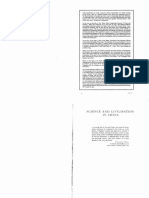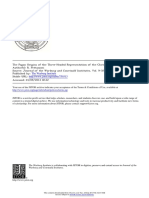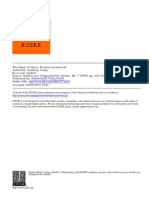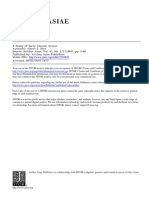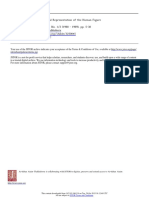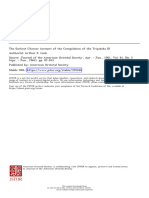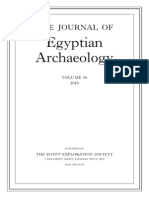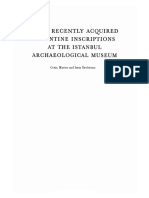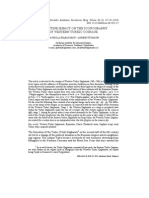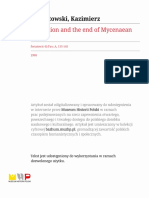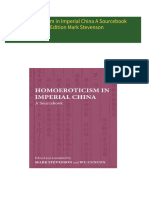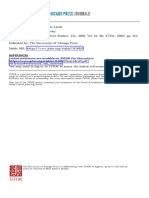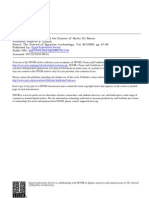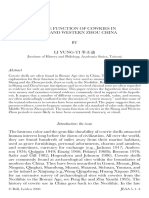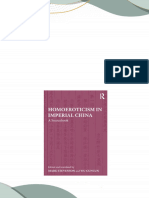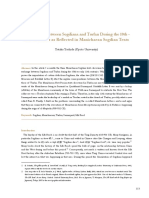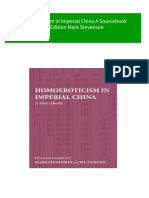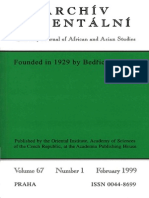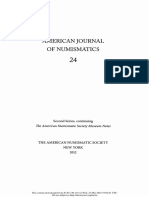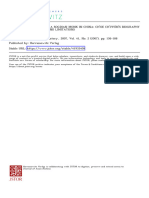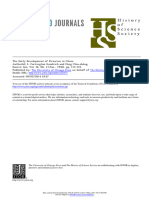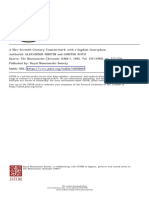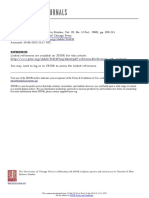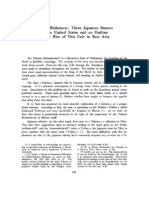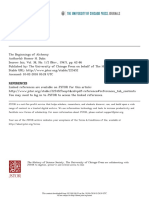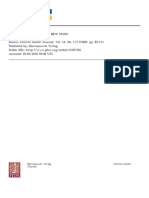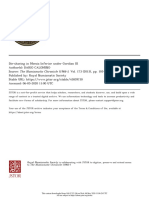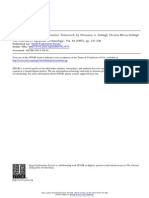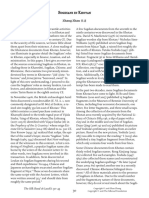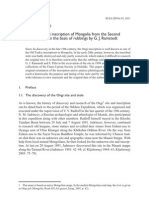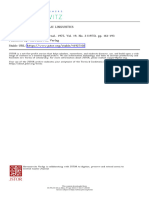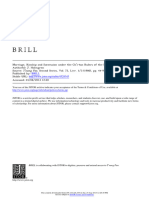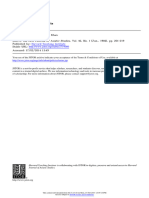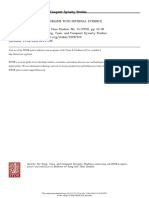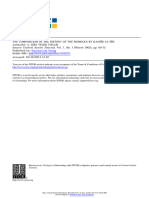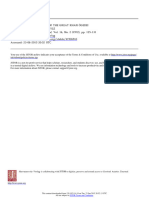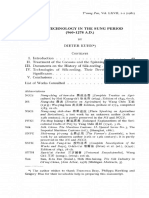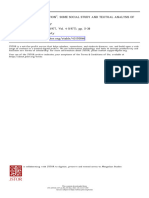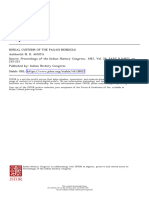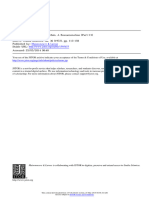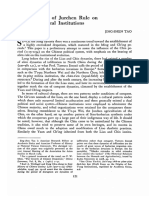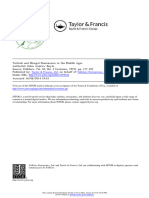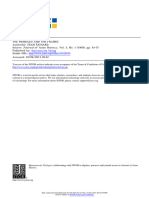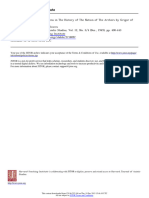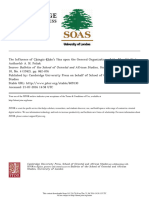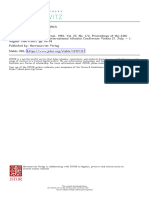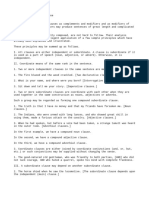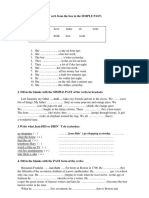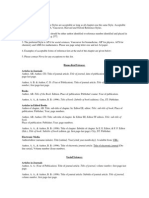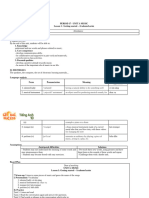1977 - N. Ts. Münküyev - A New Mongolian P'ai-Tzŭ From Simferopol
1977 - N. Ts. Münküyev - A New Mongolian P'ai-Tzŭ From Simferopol
Uploaded by
fatih çiftçiCopyright:
Available Formats
1977 - N. Ts. Münküyev - A New Mongolian P'ai-Tzŭ From Simferopol
1977 - N. Ts. Münküyev - A New Mongolian P'ai-Tzŭ From Simferopol
Uploaded by
fatih çiftçiOriginal Title
Copyright
Available Formats
Share this document
Did you find this document useful?
Is this content inappropriate?
Copyright:
Available Formats
1977 - N. Ts. Münküyev - A New Mongolian P'ai-Tzŭ From Simferopol
1977 - N. Ts. Münküyev - A New Mongolian P'ai-Tzŭ From Simferopol
Uploaded by
fatih çiftçiCopyright:
Available Formats
A NEW MONGOLIAN P'AI-TZŬ FROM SIMFEROPOL
Author(s): N. TS. MÜNKÜYEV
Source: Acta Orientalia Academiae Scientiarum Hungaricae , 1977, Vol. 31, No. 2 (1977),
pp. 185-215
Published by: Akadémiai Kiadó
Stable URL: https://www.jstor.org/stable/23682673
JSTOR is a not-for-profit service that helps scholars, researchers, and students discover, use, and build upon a wide
range of content in a trusted digital archive. We use information technology and tools to increase productivity and
facilitate new forms of scholarship. For more information about JSTOR, please contact support@jstor.org.
Your use of the JSTOR archive indicates your acceptance of the Terms & Conditions of Use, available at
https://about.jstor.org/terms
Akadémiai Kiadó is collaborating with JSTOR to digitize, preserve and extend access to Acta
Orientalia Academiae Scientiarum Hungaricae
This content downloaded from
193.255.88.137 on Fri, 03 Dec 2021 18:20:05 UTC
All use subject to https://about.jstor.org/terms
Acta Orientalia Academiae Scientiarum Hungaricae, Tomus XXXI (2),pp. 185— 215 (1977)
A NEW MONGOLIAN P'AI-TZU FROM SIMFEROPOL
ΒY
Ν. TS. MÜNKÜYEV (Moscow)
Abbreviations ο f t h e titles ο f periodicals and works u s e d
in t h i s paper:
AWKR — Archiv fur wissenschaftliche Kunde von Russland,Berlin
Bulletin 一 Bulletin de la Classe historico-philologique de L'Académie impérial
des sciences de St.-Pétersbourg, St. Petersburg
FV 一 Ohhckîh BtCTHHK'b, St. Petersburg
HHSR I — Haneda Tôru 羽田享,Haneda hakushi shigaku rombunshû
观田博士史學論文集(flollected Historical Articles of Doctor
Haneda) (Kyoto 1957)
IAN — H3BecTHH AKaAeMHH HayK CCCP, Leningrad
IIAK — H3BtCTH只 HMnepaTOpCKOH ApxeojiorHnecKOH komhccîh, St. Petersbur
I-shu — Wang Kuo-wei 王國維,Hai-ning Wang Ching-an hsien-sheng i-shu
―海寧王靜安先生遺書(Posthumous works of Mister Wang
Ching-an of Hai-ning)^ edited by Lo Chen-yu 羅振玉(Commercial
Press, Shanghai 1940)
MSAN 一 Mémoires de la Société d'archéologie et de numismatique de St.
Petersbourg, St. Petersburg
MSIA — Mémoires de la Société impériale d'archéologie de St. Petersbourg,
St. Petersburg
TVOIAO — TpyAbi BocTOHHaro Ota电《neHi只 HMnepaTopCKaro ApxeojiorHMecKaro
OÔmecTBa, St. Petersburg
ZMVD — )KypHajrb MHHHCTepcTBa BHyTpeHHHXT» A'feJi-b, St. Petersburg
ZI AN 一 3anHCKH HMnepaTOpCKOH AKa^eMÎM HayKl·, St. Petersburg
ZIAO 一 3anHCKH HMnepaTopCKaro ApxeojiorHnecKaro OômecTBa, St. Petersburg
ZSPANO — 3anHCKH CaHKTneTepôyprcKaro ApxeojiorHHecKO-HyMH3MaTHMecKaro
06mecTBa, St. Petersburg
ZVOIRAO — 3anHCKH BocTOHHaro OTAtjieHiii HMnepaTopCKaro PyccKaro Apxeojio
rHnecKaro 06ii;ecTBa, St. Petersburg
Acta Orient. Hung. XXXI. 1^77
This content downloaded from
193.255.88.137 on Fri, 03 Dec 2021 18:20:05 UTC
All use subject to https://about.jstor.org/terms
186 Ν. TS. MÛNKÛYEV
Mongolian «tablets of authority»
片卑面,1 discussed more than once
the Chinese fu 符 «tally».2 Chinese ta
was retained by the person, who r
was held by the officiai, to whom
sidered valid, only when the two h
the rise of Chingis Khan (1206 — 1
Khitans and Jurchens. This pract
them. Though Chinese political, adm
borrowed by the Mongolian conque
of the XIII century, it seems neces
ally put p'ai-tzu in use, following a
1 Ρ’ai-tzu 牌子 or ρ ai-mien 牌面,a
for the Mongol «tablets of authority».
Yuan period (1206 — 1388) these plates
(俗 su), i.e·,colloquial language and fu
Wang Kuo-wei, Yuan t'ung-hu-fu pa 元
of the Yiian» : I-shu, ts e 8,Kuan-t’ang c
cf. R. des Rotours, Les insignes en deux pa
907) : TP XLI (1952),pp. 1一148 (pp. 25
have been widely used by the Mongols in
As the resuit of contacts with them, thi
texts in respective forms, cf. H. Yule, The
throughout in the light of recent discove
1903), pp. 351一352. In the 17th c. the term altun baisa «golden baisa» adopted the
meaning «hanging seal» among the Crimean Tatars, cf. A. N. Samoilovich, Ο «naÛ3a»
一 «ôaûca» β JJytcyHueeoM yyiyce : IAN, ser. VI, vol. XX, Ν 12 (1926), pp. 1107 — 1120
(pp. 1107—1117). According to the Russian sources, the word in question is represented
in the form baisa in a copy of the yarligh, given by Berdi Beg to Aleksej, the Kievan
metropolitan (for this word cf. above). It seems to have sounded as baisa in the spoken
language of the Mongols in the 14th century. In literary Mongolian pai-tzu were called
gerege, cf. F. W. Cleaves, DARUTA and GEREGE : HJAS 16 (1953), pp. 237 — 259
(pp. 255-256).
2 For the Chinese tallies 符(fu) in ancient times cf., e.g. Yanai Watari 箭內互,
Genchô haifu ko 元朝牌符考(乂 Study of Tablets and Tallies of the Yuan Dynasty):
Môkoshi kenkyû 蒙古史硏究(Studies on Mongol History) (Tokyo 1966),pp. 839 — 898
(pp. 842 — 868) ; A. C. Moule and Lionel Giles, Christians at Chêng-chiang fu : TP 16
(1915), pp. 627 — 686 (p. 636, note 23), and R. des Rotours, Les insignes en deux parties
(fou 符)sous la dynastie des T9ang (618 — 907) : TP 41 (1952), pp. 1 — 148. On the Chinese
tallies, dating from the Sui dynasty (581 — 618) and published in the Kuo-hsûeh tsung
k^an 國學叢刊 1 and 3 (1911), A. C. Moule and L. Giles wrote in their note (see above):
«These are shaped like an animal and have a sunk cross on the left shoulder of the right
hand half, with a raised cross to fit it on the right shoulder of the left-hand half, and
certain characters engraved on the edge (the back of the tiger) which are perfect only
when the two halves are fitted together».
Acta Orient. Hung. XXXI. 1977
This content downloaded from
193.255.88.137 on Fri, 03 Dec 2021 18:20:05 UTC
All use subject to https://about.jstor.org/terms
A NEW MONGOLIAN P'AI-TZtT FROM SIMFEROPOL 187
Tôru %田享(1882—lâ^6),3 two Khitan characters correspondi
tsou-ma 走 l| «riding-horse», are engraved on the reverse of Ch
gilded tablet with a Chinese inscription found somewhere in Jeh
early in the thirties. Haneda Tôru assumed that Chingis had int
p'ai-tzû into practice, probably, on the advice of his astrologer, secr
adviser Yeh-lii Ch'u-ts'ai (1189—1243) who was a Khitan by
wrote :4 «On sait que Ye-lu Tch'ou-ts'ai 耶律楚村 d'origine K'i-i
en servant les Yuan, la confiance profonde du khan et élabora
nombreux projets ; d'où il sera permis de supposer qu'on a créé
portant les caractères en question, en adoptant exceptionnellem
manifestations de la civilisation K'i-tan.»
Regarding the purpose of the p'ai-tzû among the Mongols, in Chao
Hung's 趙洪 Meng-Ta pei-lu 蒙韃備錄[Com/plete Account of the Mongolo
Tatars) of 1221, it is stated :5 «As to the golden tablets, which [the Mong
chiefs] wear at the girdle, noble officiais of the first class bear [tablets wi
the figures of] two tigers confronted each other. [They] are called golde
tablets ’A fight of tigers’· [In the inscription on them] it is written in Chines
characters : ’An impérial edict of the emperor Ch'eng-chi-ssu (Cinggis), t
Granted by Heaven. [The bearer of this tablet] should act at [his own] disc
tion.' The next in order after these are the plain golden tablets. [In the
scription] it is said : ’An impérial edict of the emperor Cinggis, the Grant
by Heaven. Urgent·’ Then the next in order after these are silver tablet
The inscription [on them] is identical with the previous one.» As was dém
strated by Wang Kuo-wei 王國維(1877—1927),6 the expression hu-tou ch
pfai «golden tablets ’a fight of tigers’》is a phonetic error for hu-t'ou chin-p'
虎頭金牌《golden tablets (with the figure of) a tiger's head». Therefore, wh
is said of the «two tigers confronting each other» is also wrong. Nevertheless,
the gilded p'ai-tzû discovered in Jehol, and the half of Chingis Khan's silv
tablet from the former National Muséum of Manchou-kuo in Mukden, also
reproduced by Haneda Tôru in his article cited above,7 confirm that the author
of the «Meng-Ta pei-lu» rendered the Chinese inscriptions on the Mongolian
«tablets of authority» very exactly, Verbatim.8 From his report it can be seen
3 Cf. Tôru Haneda, Une tablette du décret sacré de l,empereur Genghis : MTB 8
(1936), pp. 85—91 + 1 pl. (pp. 89 — 90) ; Haneda Tôru, Chingisu kôtei seishi hai 成吉
思皇帝聖旨牌(Une tablette du décret sacré de Vempereur Genghis) : HHSR I, pp.
130—136 (pp. 133-135).
4 Cf. ibid., pp. 90 — 91 ; HHSR I, pp. 134 — 135.
5 Cf. Wang Kuo-wei, Meng-Ta pei-lu chien-cheng 蒙韃備錄箋證{Νotes to the
Complété Account of the Mongolo-Tatars) : I-shu, tsë 37, pp. 14b —15a.
6 Cf. ibid. (Wang Kuo-wei's note).
7 Cf. Tôru Haneda, op. cit.,plate, and p. 91, Appendice ; HHSR I, plate VII.
8 Cf. ibid., pp. 85-87; HHSR I, pp. 130-132.
Acta Orient. Hung. XXXI. 1977
This content downloaded from
193.255.88.137 on Fri, 03 Dec 2021 18:20:05 UTC
All use subject to https://about.jstor.org/terms
188 Ν. TS. MÜNKÜYEV
Fig. 1. The Simferopol ρ ai-tzü (ob
Acta Orient. Hutig. XXXI 1017
This content downloaded from
193.255.88.137 on Fri, 03 Dec 2021 18:20:05 UTC
All use subject to https://about.jstor.org/terms
A NEW MONGOLIAN ΡΆΙ-ΤΖΊΓ FEOM SIMFEBOPOL 189
Fig. 2. The Simferopol p'ai-tzü (reverse)
Ada Orient. Hung. XXXI. 1977
This content downloaded from
193.255.88.137 on Fri, 03 Dec 2021 18:20:05 UTC
All use subject to https://about.jstor.org/terms
190 Ν. TS. MÛNKÛYEV
that in that period golden and silver t
for high officiais. It is reported that
Juvaini9 speaks of a man who becam
received a wooden paiza from him. W
of the lowest rank·10
First of ail, military officers received «tablets of authority». For instance,
Shih T'ien-ni (1185— 1225), a myriarch (wan-hu) of the Chinese troops on the
side of Chingis Khan, received a golden tablet in 1214 near modem Peking.11
Mongolian générais, obviously, bore golden and silver tablets as a kind of
badge of rank also just as modem military officers wear their shoulder-straps.
But at that time such tablets were given simultaneously to spécial couriers
and envoys of the khan simply as orders for relays. The local chieftains of
Mongolian tribes and local authorities in the conquered countries had to
furnish the bearers of these tablets with horses and provisions on their journey
(as known, till the accession to the throne of Ôgodei Khaghan (1229—1241),
state post-relay stations had not been established yet in the Mongolian empire).
E.g., Chingis Khan's spécial envoy Liu Chung-lu 劉仲祿,leaving Central Asia
for North China to summon the Taoist monk Ch'ang-ch'un to his khan, had
with him a golden p^ai-tzû with the figure of a tiger's head (hu-t'ou chin-p'aï),
true, engraved with an inscription, which slightly differs from that in ques
tion.12 As remarked by Haneda Tôru, later in Mongolian China, when the court
issued a golden tablet with the figure of a tiger's head to an envoy or a courier,
the spécial privilèges, granted to the bearer of the tablet, were specified in
an impérial edict handed to him.13 Judging from the meaning of the Chinese
character chi 疾 «urgent» on the obverse and of the Khitan letters «riding
horse» on the reverse of the plain gilded pai-tzû, the spécial privilèges, granted
to an envoy, were limited only to demanding horses at the post stations.14
9 Cf. eAla-ad-Din eAta-Malik Juvaini, The History of the World-Conqueror, trans
lated by J. A. Boyle, vol. I—II (Manchester 1958), p. 158.
10 Cf. ibid.y note 14 by J. A. Boyle.
11 Cf. Yûan shih 元良,So-yin Po-na-pen erh-shih-ssu shih 縮印百納本二四史
[Heduced (Publication) of the Twenty-Four Dynastie Historiés of the Po-na-pen édition]
(Shanghai, Commercial Press, 1958), vol. 21, chap. 147, the biography of Shih T'ien-ni,
pp. 8a (1659/4)-12a (1661/3) (p. 10a, 1660/3).
12 Cf. Ch’ang-ch’un chen-jen hsi-yu chi 長春真人西遊記(Jccowni of a Journey
of Ch’ang-ch’un chen-jen to the West) : I-shu, tse, 39, shang, pp. 2a—b ; for a translation
cf. Archimandrite Palladius (P. I. Kafarov), Cu w if3U uau onucame nymeuiecmeiR Ha
3anadb : Tpyàbi HAemeh PocciûCKoii àyxoeHOù Mucciu eb UeKunt IV (St. Petersburg 1866),
pp. 265—434 + 2 + 1 map (p. 269) ; A. Waley, The Travels of an Alchemist (Lon
don 1931), p. 48.
13 Cf. Tôru Haneda, Une tablette ... : MTB 8 (1936), pp. 88 — 89 ; Haneda Tôru,
Chingisu ... : HHSR I, p. 133.
14 Cf. ibid·,pp. 88 and 134 — 135 respectively.
Acta Orient. Hung. XXXI. 1977
This content downloaded from
193.255.88.137 on Fri, 03 Dec 2021 18:20:05 UTC
All use subject to https://about.jstor.org/terms
A NEW MONGOLIAN P'AI-TZTJ FROM SIMFEROPOL 191
Later on, under the Ytian dynasty (1206—1388)
at least theoretically, also served the high military o
Simultaneously, many measures were taken ther
to regulate the issue of p'ai-tzû to the persons who w
tokens of authority giving great privilèges to the
the section Ping-chih 兵志(《Description of the ar
said : «The myriarchs, chiliarchs and centurions w
middle and inferior catégories. The myriarch wore a
girdle. There was the figure of a crouching tiger [en
of the tally and glittering pearls [incrusted] in th
tallies] differed by one, two or three pearls [incruste
[wore at the girdle] a [plain] tablet of gold, and th
girdle] a silver tablet.»
In China the Mongols also had round p^ai-tzû d
cussed above, in shape, the so called falcon-tablets
Originally, they were used to be given only to sp
of the khaghan travelling on military affairs. In
shih,17 it is said : «As to their (i.e., the Yiian) issu
the impérial seal for travelling on the post-relay s
,the impérial edicts for post-horses'.18 When there
ness, [they] also used round tallies with the golden in
Those with the silver inscription were the next in
internai (i.e., metropolitan) [province] these [tallie
Celestial (i.e., Impérial) treasury, and in the exter
officiais out of the compatriots (i.e., the Mongols)
But in China not only the high military officer
missions of military character, received the p'ai-tzû o
circle of the persons, who actually made use of these
very wide. First of ail, there were, besides the myria
other officiais, who enjoyed the right to be given th
tablets, in the military organizations themselves.
15 Cf. Yuan shih 98 (vol. 21), p. lb (1225/4).
16 For détails of the hai-ch^ing-j/ai,cf. Haneda Tôru 胡
元朝驛傳雑考(^cherches sur le service des postes de l
pp. 91 — 112.
17 Cf. Yuan shih 101 (vol. 21), pp. la-b (1263/3-4).
18 For the p'u-ma-sheng-chih and other documents,
horses, cf. P. Olbricht, Das Postwesen in China unter der M
14. Jahrhundert. Gottinger asiatische Forschungen I (Wiesb
19 Wai, i.e. «external» [provinces] included ail the prov
with the exception of the «internai» (nei) territory contro
government (chung-shu-sheng). Cf. P. Ratchnevsky, Un cod
Acta Orient. Hung. XXXI. 1977
This content downloaded from
193.255.88.137 on Fri, 03 Dec 2021 18:20:05 UTC
All use subject to https://about.jstor.org/terms
192 Ν. Ϊ8. MVNKÛYEV
hu-fu «administration de myriarque»
units lu of the empire, subordinate o
wore golden and silver tablets at the
were put at the head not only of milita
of civil administrative organs too, h
crouching tiger·22
The oblong tablets also were issued
civil administration. Thus, in each pr
sheng) two senior officiais were entitle
of a tiger in witness of their right to b
In the shang-yin-chû fàj飮周 «Bureau in
(modem Peking), founded in the fo
engaged in making «fine spirits» 糸81、
大使 «great commissioner» of this in
plain p'ai-tzû of gold.24 The office of a
was created in the yû-chiu-kyu 御酒庫
Daidu the same year and making bit
and government officiais, and the hs
tablet.25
During the Yuan period important
tinued, as before, to be given oblong
it is known that when Marco Polo's father and uncle Nicolo and Matteo left
Daidu for Italy on a mission to the pope from Qubilai Qayan (1260— 1294
the latter handed a golden p’ai-tzû to them as a document entitling them t
receive horses, escort and everything-necessary at the post-relay stations
their journey in ail the conquered countries.26
The grant, by the government, of the round p^ai-tzû originally intended
only for the couriers travelling on some military business, was also not r
stricted in this sphere. The following text, showing this, is contained in Yiian
ehih :27 «In the sixth moon [of the second year of the period Huang-chein
(June 24—July 23,1313) an officiai of the [Central government] chung-sh
sheng28 said [to the emperor] : 'The tien-jui-chien (Inspection in charge
20 For détails of the wan-hu~fu or administrations de myriarque cf. P. Ratchnevsky
op. cit., p. 144, note la.
21 Cf. ibid., p. 238, note 7.
22 Cf. A. C. Moule and L. Giles, op. cit., p. 636, note 23.
23 Cf. P. Ratchnevsky, op. cit., p. 135.
24 Cf. Yuan shih 87 (vol. 20), p. 16b (1073/2).
25 Cf. ibid., p. 17a (1073/3).
26 Cf. H. Yule, op. cit., p. 15.
27 Cf. Yuan shih 101 (vol. 21), p. 9a (1267/3).
28 For détails of the chung-sliu-sheng or Central government of the Yüan cf. P.
Ratchevsky, op. cit., pp. 117 — 132.
Acta Orient. Hung. XXXI. 1977
This content downloaded from
193.255.88.137 of:ffff:ffff on Thu, 01 Jan 1976 12:34:56 UTC
All use subject to https://about.jstor.org/terms
A NEW MONGOLJAN P'AI-TZU FROM SIMFEROPOL 193
sceptres)29 had been in charge of round tablets with the golden in
and more than three hundred copies of the imperial edicts for rel
In the fourth year of Chih-ta (1312) ail [the copies of] the imperial ed
transmitted to the Academy of Literature (han-lin-yüan)30 and on
of the fact that the round tablets with the golden inscription were ins
fifty more pièces [of them] were introduced. As to sending envoys wi
tablets, it was first instituted because of important affaire in the
situation, and it would not be fitting to overissue [them], When
officiai] seeks for the tablets and [the court] has to issue [them], i
fitting from now on not to grant [them], if [the appropriate docu
not passed through the chung-shu-sheng and Military Council.31 [The
followed it.» This measure seems to have been necessitated by the
besides the military officers and government officiais, too many peop
led on the state post-relay system, causing too much damage to th
engaged in supplying it with everything required. It would be eas
much more records on this subject in the sources, but here it will
to refer to Haneda Tôru who wrote that many Mongolian princes,
and Buddhist monks had also received the falcon-tablets and corre
high privilèges.32
Although in the Yiian period the Mongolian rulers, following the
bureaucratie system with its tendency of elaborating clear régu
everything, even if only on paper, tried to put the issue of golden
tablets in order and restrict their use only in the sphere of the milit
tions, but in Mongolian China these p'ai-tzü on the whole, remained, a
tokens of high favour and honour, which the khaghan could award to
as he chose. From this général rule only the military couriers, perhap
excluded, the p'ai-tzü having been taken back from them after th
from their mission.
In Iran, the other part of the Mongolian empire, the p'ai-tzü, which are
often spoken of by Ata-Malik Juvaini (d. 1283), Rasïd-ad-Dïn (1247 — 1318)
and other Persian authors, as well as in Mongolia and China, were granted
to military officers, officiais, vassal rulers, merchants, représentatives of the
29 On the tien-jui-chien it is said in the Yuan shih 88 (vol. 20),pp. 2a—b (1081/3 —
4) : Tien-jui-yuan 典瑞院(《Court in charge of sceptres»). [It] was of the primary se
cond grade in rank. [It] kept impérial seals and golden and silver tallies and tablets.
Only in the first year of Chung-t'ung (1260) two secretaries in charge of tallies and
impérial seals 符寶良(5 fu-pao-lang were put [there] ... In the eighteenth year [of
Chih-yuan] (1281) [it] was reformed into tien-jui-chien. [It] was of the primary third
grade in rank.
30 For détails of the fum-lin-yuan or Impérial Academy (engaged, primarily, in
translating texts) cf. P. Katchnevsky, op. cit., pp. 147 — 15】.
31 For the ch'u-mi-yuan or Military council of the Yuan cf. ibid.,pp. 140—141.
32 Cf. Haneda Tôru, Genchô ekiden zakkô : HHSR /, p. 105.
Acta Orient. Hung. XXXI. 1977
This content downloaded from
193.255.88.137 on Fri, 03 Dec 2021 18:20:05 UTC
All use subject to https://about.jstor.org/terms
194 Κ. TS. MUNKÜYEV
Church, envoys and couriers as tokens of authority giving their hold
privilège of taking horses and supplies at the post-relay stations. Th
of tliem, as a rule, was accompanied by the yarlighs,33 in which the righ
these people were determined in detail. The Mongolian tablets in that cou
were made of gold, silver34 and copper.35 Thus, Abagha Khan (1265
in 1281 handed a golden fablet, yarligh and seal to Mar Yahballaha af
had been elected Patriarch of the Nestorians, and later Geikhatu Khan (12
1295) granted him a golden p'ai-tzü with the figure of a falcon.36 Ma
reported that in 1291, on his way back from China to Venice via Iran Ge
Khan had given him, his father and his uncle a füll four golden tabl
said :37 «And before their (i.e., the Polo brothers and Marco Polo hi
departure, Kiacatu gave them four golden tablets of authority, two of
bore gerfalcons, one bore lions, whilst the fourth was piain, and hav
scriptions on them which directed that the three Ambassadors should
honour and service all through the land as if rendered to the Prince in p
and that horses and all provisions, and everything necessary, should
plied to them.» Under Ghazan Khan (1295—1304) who, according to
ad-Din, had introduced new p'ai-tzü and had established a new syste
employing them in Iran, military officers and rulers of the districts rec
round p'ai-tzü with the figure of a tiger's head and engraved with th
of the holder.38 Rasid-ad-Din does not say what metal they were m
But these p'ai-tzü seem to have been of gold, because they were of di
dimensions for différent catégories of officiais.39 Couriers riding ula
horses taken from the local peasants, also had round p'ai-tzü but these
bore the inscription «State p'ai-tzü» (K33eHHaH naii3a in Russian translati
Couriers travelling post-haste with horses, taken at the post stations
given oblong tablets of copper with the picture of the moon.41 The
were to be returned to the court after the retirement of the given
or return of the given messenger.42
33 Cf., e.g., 'Ata-Malik Juvaini, op. cit., vol. I, pp. 255 and 257, and vol. II,
487, 488, 489 ; Rasïd-ad-Dïn, CôopmiK Aemonuceü III, translated from Pers
A. K. Arends (Moscow—Leningrad 1946), pp. 119 and 264.
34 Cf. Rasïd-ad-Dïn, op. cit., p. 280.
35 Cf. ibid., p. 278.
36 Cf. B. A. W. Budge, The Monks of Kûblai khân Emperor of China (London
pp. 60 and 75.
37 Cf. H. Yule, op. cit., p. 35.
38 Cf. Rasïd-ad-Dïn, op. cit., pp. 277 — 278.
39 Cf. ibid., p. 278.
40 Cf. ibid.
41 Cf. ibid.
42 Cf. ibid.
Acta Orient. Hung. XXXI. 1977
This content downloaded from
193.255.88.137 on Fri, 03 Dec 2021 18:20:05 UTC
All use subject to https://about.jstor.org/terms
A NEW MONGOLIAN P'AI-TZU FBOM SIMFEROPOL 195
There were very many p'ai-tzü in Iran because they were issu
-as bad been in Mongolia earlier, not only by the Ilkhan, but by t
khatuns and other représentatives of the Mongolian nobility as well.4
Comparatively less information on p'ai-tzu in the Golden Horde (
1502) is contained in the sources, though, as will be demonstrate
the former dominions of this Mongolian ulus more specimens of the
«tablets of authority» were found than anywhere eise. These wer
tablets discussed below. It is reported that the khans of the Gold
Öz Beg (1312— 1342), his son and successor Jani Beg (1342— 1357)
Beg (1357 — 1359), son, murderer and successor of Jani Beg, gran
(baisa, baissinum and paysam) together with yarlighs with a red s
tians, conferring privilèges on them, in 1333, 1344 and 1358 re
a golden tablet being dealt with in the case of Jani Beg.44
As stated by D. Banzarov (1822—1855), as early as 1846, B
granted a baisa (p'ai-tzü) and yarligh to the Kievan metropolitan
whom, as well as on other heads of the Russian Orthodox Church at
times, privilèges were conferred on by the khan of the Golden Hord
article on the p'ai-tzü from Grusevka, D. Banzarov, citing his source,
to a Russian version of Berdi Beg's yarligh in an old Russian manu
by Α. I. Artem'ev in Kasan and containing, among other documen
translations of six yarlighs given to the Russian clergy by the kh
Golden Horde.46 In his note 12 to this article of D. Banzarov, P. S. Savel'ev
(1814-1859), who had received a letter from Α. I. Artem'ev concerning the
manuscript and the word baisa contained in it, cited the whole passage in
question from this manuscript (in D. Banzarov's article the dates of the
document were omitted);47 Tant percme 6aiîcy ga gpjibiKt et anoio TaMroro garni
43 Cf. 'Ata-Malik Juvaini, op. cit., vol. I, p. 255, and vol. II, p. 598 ; Rasïd-ad
Din, op. cit., p. 278, and Сборник летописей II, translated from Persian by Ju. P.
Verchovskij (Moscow—Leningrad 1960), pp. 119 —120, and 141.
Cf. H. Yule, op. cit., p. 352.
45 Cf. D. Banzarov, Пайзе, или металлическая дощечки съ повельтями монголь
скихъ хановъ: ZSPANO II (1850), pp. 72—97 (р. 94) ; Paise oder Metallplatten mit den
Befehlen der Mongolischen Chane als Inschrift: MSI A V (1851), pp. 328 — 339 and
VI (1852), pp. 441—448 (p. 448); Черная etpa или шаманство у монголовъ и друггя
статьи Дорджи Банзарова, edited by G. N. Potanin (St. Petersburg 1891), pp. 47—64
(p. 63); Собрание сочинений (Moscow 1955), pp. 140 — 160 (pp. 159 — 160).
46 On the manuscript from the end of the XVII or beginning of the XVIII Cen
tury, which belonged to archaeologist A. I. Artem'ev (1820—1874), See D. Banzarov's
note on the same pages cited above in note 45. See also note 47 below.
47 Cf. D. Banzarov, Пайзе: ZSPANO II (1850), pp. 96 — 97; Черная etpa,
p. 64; Собрание сочинений, pp. 159 — 160 (note 12 of P. S. Savel'ev, not included in
the German version of the article in question Paise oder Metallplatten . . .). The texts
of the yarlighs mentioned were studied most thoroughly by M. D. Priselkov (1881 —
1941) on the basis of différent copies (the manuscript, which was once in A. I. Artem'ev's
Acta Orient. Hang. XXXI. 1977
This content downloaded from
193.255.88.137 on Fri, 03 Dec 2021 18:20:05 UTC
All use subject to https://about.jstor.org/terms
196 X. TS. MÜNKÜYEV
ecMbi Ha yTBep>KÄeHie BaMb, Ter
MU,a Bb ceMb coTb ocbMoe. — «
yarliq with the red seal for the
[day] in the first phase of the
the month Dhu-l-Qa'da of the [
(1881 — 1941), one of the manu
Berdi Beg's yarligh is to be fou
Century (true, he does not men
texts studied by him).48 He po
the last date in the Moslem cale
is impossible) and that all such d
clergy, were not in agreement
khans,49 while the first date of
responded to November 1357, i.
Golden Horde.50 The last date c
as November 21, 1357.
Speaking of the Russian clergy, who had received a p'ai-tzü from the
khan, D. Banzarov supposed that the Russian princes, subject to the Mon
golian khans, had also been given p'ai-tzü by the khans of the Golden Horde,
because they had regularly been invested with their authority by the ordu
receiving special yarlighs to this effect from there.51
As far as I know, there are no records in the historical sources as to
which catégories of people held «tablets of authority» in the Golden Horde
itself. No doubt, the khans gave them to représentatives of the Mongolian
nobility. One can assume that military officers —myriarchs, chiliarchs and
centurions — had p'ai-tzü as tokens of authority, as similar officers did in
China and Persia. Of course, the khan'senvoys and couriers, sent to différent
parts of the state with khan's Orders, were furnished with p'ai-tzü. Such en
voys are often spoken of in Russian chronicles (true, references to p'ai-tzü are
very rare in these sources).
P'ai-tzü of gold and silver were mentioned above. It is not known if
there existed copper tablets in the Golden Horde, as in Persia. But one source
possession, is not mentioned by him, cf. M. D. Priselkov, Хантя ярлыки русскимь
митрополитамъ, Petrograd 1916, VIII -f 116 pp. The passage, cited above, reads in
his wording (cf. ibid., p. 103) : «... тако рекши баисоу да ярлыкъ съ алою тамгою да
ли есмы на утвержеше вамъ тетигоуа (-я) лЪта десятаго мЬсяца въ семь сотъ осяе (-осмое)
сылгата мЬсяца въ десятый нова.»
48 Cf. M. D. Priselkov, op. cit., pp. 47 — 48.
49 Cf. ibid., p. 46.
50 Cf. ibid., p. 69.
61 Cf. D. Banzarov, Пайзе : ZSPANO II (1850)_ pp. 93 — 94; Paise: MSI A V
p. 448; Черная etpa, pp. 63—64; Собрание сочинений, p. 159.
Acta Orient. Hung. XXXI. 1977
This content downloaded from
193.255.88.137 on Fri, 03 Dec 2021 18:20:05 UTC
All use subject to https://about.jstor.org/terms
A NEW M0NG0LIAN P'AI-TZU FEOM SIMFEEOPOL 197
seems to enable us to assume that khan's envoys somet
wooden ones too. Thus, in one of the Russian chronicles,
скш Летописецъ «Kazan chronicle» of 1564—1566, it is
Ахматъ BocnpiHTb царство Златыя орды по отце своемъ Зе
и посла къ великому князю Ивану къ Москве послы св
обычаю отецъ своихъ, зъ басмою, просити дани и оброковъ
Великш же князь ни мало убоявся страха царева, но, пршм
и плевавъ на ню, и излама ея, на землю поверже и потопта ногама своима...
«King Akhmat took the kingdom of the Golden Horde after his father Zeleti
saltan53 and sent his envoys to Grand Prince Ivan to Moscow, with a basma,
in accordance with the old custom of his ancestors, to demand the tribute
and levies for the last years. The Grand Prince did not become frightened34
in the least with the threat on the part of the king, but, taking the basma
of his face55 and having spat upon it, broke it, threw [it] to the ground and
trod [on it] with his legs...» Неге the question is how Ivan III (r. 1462— 1505)
received the envoys from Akhmed, the khan (ca. 1465 — 1481) of the Golden
Horde, in 1476, when the dependency of the Russian princes on the Golden
Horde had been much weakened. Earlier this year Akhmed had ordered
Ivan III to report to the ordu, i.e., to his capital or his camp in the steppe,
personally, and now he only asked the Russian tsar to send a tribute to him.
This passage of the chronicle, possibly, distorted, is not very clear from the
expression пршмъ басму лица его «taking the basma of his face» and was
interpreted differently in literature.56 For example, M. Y. Lomonosov (1711 —
1765) understood the word basma as повелительную грамоту с изобра
52 Cf. Полное Собрате Русскихъ Jltmonuceü, изданное по высочайшему noeeAtmw
Императорскою Археографическою КомисИею, Vol. 19, Hcmopiu о Казанскомъ qapcmet
(Казанскш лШописецъ) (St. Petersburg 1903), p. 200.
53 Zeletisaltan is Jelal-ad-Din, one of the sons of Tohtamys (r. 1377 —1395).
54 . . . убоявся. This word is translated here from the form taken in one of the
main copies of the chronicle. Cf. Полное Собрате Русскихъ JItmonuceü, vol. 19, p. 200,
note 66.
55 The expression npiuM басму лица его is cited here in the form taken in th
most important copies of the chronicle. Cf. ibid., note 67. This form was discussed
P. M. Melioranskij. Cf. P. Melioranskij, Что такое «басма» золотоордынскихъ по
хана Ахмата? : ZVOIRAO, vol. XVII, fasc. I (1906), pp. 0129—0140 (p. 0129). Fo
discussion of this article cf. Протоколъ засЪдатя 17 ноября 1905 года: ibid., pp
-XVIII.
56 For a review of the literature on the term basma and the
cf. K. Inostrancev, Кь вопросу о «басмр>: ZVOIRAO, vol. XV
pp. 0172—0179 (pp. 0172—0176); N. P. Lichacev, Басма золото
Сборникъ статей въ честь графини Прасковьи Сергеевны Уваров
70—86 (pp. 70—76). Of the literature on this term of more r
receive the article by H. Ortekin, Basma'ya ve Baysa'ya dair in Tü
2 (1939), pp. 65 — 71.
4* Acta Orient. Hung. XXXI. 1977
This content downloaded from
193.255.88.137 on Fri, 03 Dec 2021 18:20:05 UTC
All use subject to https://about.jstor.org/terms
198 χ. τ», λΐϋχκϋγκν
>KeHneMt> LiapeBbiMi. Ha neuaTH
the King on the seal», which Ivan II
1906) interpreted the expression i
«impression, plate with an impr
(a seal),59 as οτπε^τοκΒ JiHU,a xaH
regarding the word basma itself, wr
τ. e. ocoôaro poAa neuaTb ci> H3o6pa
Bceh (Jwrypbi xaHa «According t
peculiar kind with the picture of
figure of the khan.» Ν. P. Lichac
as a seal on a yarligh imagining
in his temper, to which the end
it convenient for keeping it intact.
A. A. Spicyn (1858 — 1931), to my
being discussed, the basma meant
ported by A. N. Samojlovic (1880
clusion :65 ripHHHMafl BO BHHM3HH
57 Cf. M. Lomonosov, Краткой росай
burg 1760), p. 26, note.
58 Cf. ibid., p. 26.
59 In Russian
and lexicogr historical
explained as оттиск, пластинка С отти
taneously inadequately defined also as a
современного русского литературного языка (A Dictionary of the Modem Literary
Russian Language), edited by V. I. Cernysev, vol. I A— Б (Moscow—Leningrad 1950),
p. 291, it is explained as follows : В эпоху татарского ига на Руси — печать с изобра
жением ордынского хана. Резное или лепное изображение ордынского хана. — «In
the epoch of the Tatar yoke in Rus' a seal with the figure of a Khan of the Horde,
engraved or a plastic figure of a Khan of the Horde.» Here the Compilers of the dic
tionary refer to N. M. Karamzin (1766 — 1826), who wrote that envoys of the Golden
Horde, Coming to Moscow, «usually brought with them a basma, the image or statue
of the Khan» (обыкновенно привозили с собой басму, образ или болван Хана) (ibid.).
This word is defined in the same way in the dictionaries edited by D. N. Usakov (Тол
ковый словарь русского языка, vol. I, Moscow 1935, p. 34/1), M. P. Alekseev and others
(Словарь русского языка, vol. I, Moscow 1957, p. 67) and other lexicographical works.
60 Cf. P. Melioranskij, op. cit. : ZVOIRAO, vol. XVII, fasc. 1, p. 0129.
61 Cf. ibid., p. 0138.
62 N. P. Lichacev, op. cit., p. 86 : Великш князь, плевав на печать, переломилъ
палочку, бросилъ ярлыкъ на землю и топталъ ногами «The Grand Prince, having spat
upon the seal, broke the wooden stick, threw the yarlyk to the ground and trod down
with his legs».
63 Cf. K. Inostrancev : ZVOIRAO, vol. XVIII, fasc. IV (1908), pp. 0172-0179
(especially pp. 0173, 0177—0178); A. Spicyn, Tатарсмя байсы : HAK 29 (1909), pp.
130-141 (pp. 130-132).
«Cf. A. N. Samoilovic, op. cit., IAN, ser. VI, vol. XX (1926), pp. 1118-1120.
65 Cf. ibid., p. 1120.
Acta Orient. Hung. ΧXXI. 197
This content downloaded from
193.255.88.137 on Fri, 03 Dec 2021 18:20:05 UTC
All use subject to https://about.jstor.org/terms
A NEW JIONftOLIAN P'AI-TZU FROJI SIMFEROPOL 199
формулы на квадратной печати» и «вислой печати» слово «6ajca» полу
поздно и при этом, повидимому, только в Крыму и что в слове «басм
занского Летописца допустимо усматривать изменение слова «6ojc
более, по-моему, приемлемым представляется объяснение «басмы
Иностранцева и А. А. Спицына как «верительной дощечки» «Taking i
account that the word baisa obtained its new meanings 'wordy form
a square seal' and later 'hanging seal' and besides, apparently, only
Crimea, and that in the word 'basma' of the Kazan chronicle it is admissible
to see a modification of the word 'baisa', the explanation of the 'basma' by
K. A. Inonstrancev and A. A. Spicyn as 'tablet of credence', in my opinion,
looks acceptable.» It seems to me that Mo. baisa was transformed into Russ.
basma in the Russian chronicle, perhaps, by one of the Compilers or a co
pyist through the presence of letters engraved in it making it look like a
basma, i.e., a plate engraved with some figures. K. A. Inostrancev seems to be
correct when he supposes that in this case the baisa was ofwood. He wrote t66
Великш князь, взявъ деревянную дощечку, могъ оплевать ее, разломать,
бросить на землю и потоптать «The Grand Duke, taking a wooden tablet,
could spit upon it, break it, throw it to the ground and trample on it.»
Although not all the sources containing information on p'ai-tzü in the
Golden Horde are mentioned above, it must be admitted that they are not
so many and, as said before, do not give so much data on the Mongolian
«tablets of authority», as the Chinese and Persian works do. But on the former
territory of this Mongolian ulus and in the régions adjacent to it much more
similar tablets were found than in Mongolia, China or Persia.
Düring the XIX c. five silver and one iron p'ai-tzü were discovered on
the territory of Russia. Three of them are with the inscriptions in hP'ags-pa
script, and three in the Uighur alphabet.
As early as 1846, the merchant G. M. Ananin obtained an oblong silver
p'ai-tzü with the inscription in hP'ags-pa script found, together with several
other items of the same métal, somewhere in the Minusinsk Circuit (okrug)
of the Yenisei Government (gubernija), and presented them to the Tsar
Nikolai I (r. 1825—1855). The inscription was translated into Russian by
Archimandrite Avvakum (Dmitrij Sem'enovic Cestnoj, 1799 — 1866) who was
one of the first, if not the first, in Europe to master texts in hP'ags-pa script,
and in the same year he published it in the article on the tablet written by
V. Y. Grigor'ev (1816 —1881).67 Archimandrite Avvakum who had kept a сору
66 Cf. К. Inostrancev, op. cit. : ZVOIRAO, vol. XVIII, fasc. IV (1908), p. 0178.
67 Cf. V. V. Grigor'ev, Объяснеше Монгольской надписи, найденной въ Сибири:
ÊMVD 16 (1846), pp. 126 — 149 -j- 1 fig. (for a separate issue see V. V. Grigor'ev, Мон
гольская надпись временъ Монгкэ-хана, найденная въ Восточной Сибири. Чтете и
переводъ архимандрита Аввакума. Издана с присовокуплетем изследовашя о письменахъ
у Монголов В. В. Григорьевым. (Изъ Журнала Министерства Внутреннихъ ДЪлъ). (St.
Acta Orient. Hung. XXXI. 1977
This content downloaded from
193.255.88.137 on Fri, 03 Dec 2021 18:20:05 UTC
All use subject to https://about.jstor.org/terms
200 N. TS. münküyev
of the inscription with him only fo
ri-yin le'u-c'un-dur «By the strengt
Khaghan (1251 — 1259), because th
two lines of the text on the ob vers
for an imperial title or name, and
tained no immédiate contact with th
Khaghan's name and assumed tha
script. Te question was that in the t
been written in the hP'ags-pa script,
in 1269. This gave rise to a contro
I. J. Schmidt (1779—1847), on one
on the other.68 Quite soon D. Banzar
Petersburg 1846), pp. 1 — 26 -f 1 tab
(1847), pp. 200—209 (review). For anot
Ueber eine mongolische Quadratinschrif
nastie Juan in China : St. Petersburgisc
надпись изъ временъ Монголъскаго владычества: Санктпетербургстя Ведомости 249
[1846] (a Russian translation of the German original) ; Библттека для чтетя 79 [1846],
(section) III Науки и художества, pp. 1 — 6 (the Russian translation ofthe German ori
ginal) ; Ueber eine mongolische Quadratinschrift aus der Regierungszeit der mongolischen
Dynastie Juan in China (read February 12, 1847): Bulletin 4, Nr 9 (1848), pp. 129 —
141 -f- 1 table (an amended variant of the previous article) ; D. Banzarov, Пайзе:
ZSPANO II (1850), pp. 76-79 ; Paise : MSI A V (1851), pp. 330-333 ; Черная etpa, pp.
49—58 ; Собрание сочинений, pp. 143—146. For a translation and notes cf. also Grigor'ev,
Lettre adressée à la Société Asiatique de Paris sur l'origine et les monuments de l'écriture
carrée, dont l'invention est attribuée au Pagba-lama : JA, sér. 5, t. XVII (1861), pp. 522
— 558 (pp. 529—558) ; A. M. Pozdneev, JleKifiu no ucmopiu монгольской литературы II
(St. Petersburg 1897), pp. 129 —134; В. Laufer, Skizze der mongolischen Literatur :
Keleti Szemle VIII (1907), pp. 165 — 261 (p. 195). For a new transcription and trans
lation of the inscription see N. Poppe, The Mongolian Monuments in hP'agspa Script,
Second Edition, translated and edited by J. R. Krueger, (= Göttinger asiatische For
schungen 8) (Wiesbaden 1957), p. 57—58. For the most recent transcription of the text
see also L. Ligeti, Monuments en écriture 'phags-pa (Monumenta linguae mongolicae col
lecta III) (Budapest 1972), pp. 109 — 110. For a reproduction cf. also H. Yule, op. cit.,
plate facing p. 352 ; Восточное серебро. Атласъ серебряной и золотой посуды восточного
происхождетя (St. Petersburg 1909), table XCIV ; A. Spicyn, op. cit., IIAK 29 (1909),
p. 133, Plate ; E. A. W. Budge, op. cit., plate V ; Yanai Watari, op. cit., plate facing p.
894 (there the p'ai-tzü is erroneously called golden) ; Haneda Tôru, Genchô ekiden
zakkô : HHSR I, plate I; N. Poppe, op. cit., plate VII. The p'ai-tzü in question is
now exhibited in hall N° 365 (the section Искусство Монголии, «Art of Mongolia») in
the Hermitage Museum in Leningrad.
68 On this controversy cf. I. J. Schmidt's article on the Minusinsk p'ai-tzü (see
note 67). Cf. also V. Grigor'ev, Ometmb Г. Академику Шмиту на замЪчатя его о Мон
гольской надписи временъ Монгкэ-хана, найденной въ Восточной Сибири : Отечественныя
записки (December 1846), pp. 114—120 (there is also a separate, pp. 1 — 14); Второй
ometmb Г. Академику Шмидту на новые eaMinamn его о Монгольской надписи временъ
Acta Orient. Hung. XXXI. 1977
This content downloaded from
193.255.88.137 on Fri, 03 Dec 2021 18:20:05 UTC
All use subject to https://about.jstor.org/terms
A NEW MONGOLLAX P'AL-TZG from simferopol 201
was correct concerning his translation of the word, an in
initial formula in Mongol documents, and in reference to
inscription in question was written in.69
The other oblong silver tablet with the text in hP'ags-pa
by P. S. Savel'ev (18 1 4—1859),70 was discovered, togeth
Монгкэ-хана: FV 5 (May 1847), section IV, Науки и художества,
vel'ev : MSAN I (1847), (supplément to volume I of) Bulletin de
— 39 (proceedings of the Society of March 10, 1847), and ZSPAN
pp. 112 —113 (proceedings of the Society of April 17, 1847); W. Sch
Bemerkungen zu der mongolischen Inschrift des Pater Awwakum:
325—327 ; I. Bicurin (Iakinf, Hyacinth), ЗамЪчатя по поводу спора о
временъ Мункэ-хана: FV 5 (Мау 1847), pp. 1 — 20; D. Banzarov,
golischen Inschrift aus einer in Jekaterinoslaw'sehen Gouvernement auf
Barons A. von Stieglitz ausgegrabenen Silberplatte (read May 19, 18
(1848), pp. 129 — 139 + 1 table (pp. 134—138), and Разяснение од
писи на серебряной дощечке, найденной в Екатеринославской губерн
фон Штиглиц (a Russian translation of the previous article) : Соб
pp. 125—139 (1 table on p. 126) (pp. 132 — 138) ; Пайзе: ZSPANO
87 ; Paise : MSIA V (1851), pp. 330 — 339, and MSIA VI (1852), p.
pp. 49—58 ; Собрание сочинений, pp. 143 — 153; P. Savel'ev, О ж
джи Банзарова: TVOIAO II (1856), pp. 128 — 160 (pp. 138 — 141), and the same ar
ticle, ZIAO IX (1857), pp. 1-33 (pp. 11-13).
69 Cf. note 68 above (D. Banzarov's articles). Though D. Banzarov did not agree
with the rendering of some terms by I. J. Schmidt, but he, actually, held with him in
deciding the two main problems of the discussion mentioned above. But it should be
noted that later on some authors continued to consider I. J. Schmidt wrong on the
whole. E.g., in 1856 P. S. Savel'ev stated again that V. V. Grigor'ev's view of the hP'ags-pa
script and Avvakum öestnoj's translation of the inscription on the Minusinsk tablet
were solely correct (cf. note 68 above). Even forty-five years later, in 1891, G. N. Potanin
(1835 —1920), calling ail the discussion «a controversy between the German Schmidt»
(споръ между немцемъ Шмидтомъ) and «a circle of Russian orientaliste» (кружкомъ
русскихъ ор1енталистовъ) wrote that D. Banzarov «had joined the opinion of Gri—
gor'ev» (примкнулъ къ мнкнию Григорьева) about the Tangyut origin of the hP'ags-pa
alphabet (cf. G. N. Potanin, Очеркъ жизни и дЪятелъности Дорджи Банзарова : Черная
etpa, pp. IX—XXXIV (p. XIX). Не also wrote : «. . . Къ удовольствию русской партш,
Банзаровъ нашелъ Шмидта не правымъ и въ том, что онъ оспаривалъ правильность пе
ревода надписи, сделанного о. Аввакумом» (ibid., p. XX) [«. . .То the delight of the
Russian party, Banzarov found Schmidt wrong also in the case when he (i.e. Schmidt)
had disputed the correctness of the translation of the inscription made by Father
Avvakum»].
70 For a description of the tablet (without any translation of the inscription)
cf. P. S. Savel'ev, Монгольское пайзе, найденное в Забайкальской области: TVOIAO
II (1856), pp. 161 — 165 (a drawing of the obverse on p. 164), and ZIAO IX (1857),
pp. 34—38 (a drawing of the obverse on p. 37). For a description of the p'ai-tzü and a
translation of the inscription see A. M. Pozdneev, Лекцш II, pp. 135—136. On this
p'ai-tzü see also В. Laufer, Skizze, pp. 195 — 196. For a transcription and translation
of the text cf. N. Poppe, op. cit., pp. 57 — 58; and for a transcription of it cf. also L.
Acta Orient. Hung. XXXI. 1977
This content downloaded from
193.255.88.137 on Fri, 03 Dec 2021 18:20:05 UTC
All use subject to https://about.jstor.org/terms
202 X. TS. M(;NKivVEV
silver articles, in a small barrow ne
dinsk Circuit of the Transbaikalian
Besides, we know the round iron
extracted from the earth in 1881 b
tol72 volosf of the Mariinsk Circuit o
by A. M. Pozdneev (1851 — 1920).73
In 1848, two years after the findin
tablet with the inscription in Uighu
on a brickwork revealed by the flo
Stieglitz (1814—1884) in the villa
Ligeti, op. cit., p. 111 — 112. For a reprod
IX, p. 132; Восточное серебро, table XCIII ; A. Spicyn, op. cit., p. 134 (table); N.
Poppe, op. cit., plate VIII; N. V. Pigulevskaja, История мар Ябалахи III и раббан
Саумы, Исследование, перевод с сирийского и примечания.. ., (Moscow 1958), р. 131, а
photograph with the erroneous legend Золотая пайдза, найденная в Верхнеудинском
уезде в 1853 г. («А golden paidza found in the Verkhneudinsk district in 1853»). Now
the silver tablet is exhibited in hall 365 (the section Искусство Монголии «Art of Mon
golia») in the Hermitage Museum in Leningrad.
71 Nyuki exists hitherto and is a Buryat village about three kilométrés to the
east of Kabansk, the centre of the Kabansk District (ayimay) of the Buryat ASSR.
In 1926 the sandy-hill on the right bank of the Selengha near an old Jewish cemetery
about two kilométrés to the east of Kabansk, not far from Nyuki, was investigated by
A. P. Okladnikov who found tools of the late neolithic period there. Cf. A. P. Okladni
kov, Следы доисторических культур на севере Селенгинской Даурии: Северная Азия III
(1928), pp. 63—69.
72 The former village of Boghotol is now a town 16 kilométrés to the south-west
of Acinsk in the Krasnojarsk Territory.
73 For a description and translation of the p ai-tzu cf. A. M. Pozdneev, Объяснение
древней монгольской надписи на чугунной дощечке,доставленной вь Императорскую Ака
deMito Наукъ г. Винокуровымь: ZIAN 39 (1881), pp. 31 — 43 + 1 plate (there exists
also a separate, pp.1—13 + 1 plate), and Лекцш IT, pp. 153 — 154 + 1 plate (facing
p. 152). On this tablet see also V. R. Rozen : ZIAN 39 (1881), p. 58 (proceedings of the
Historico-philological branch of the Imperial Academy of Sciences of the 6 Oktober,
1881). For a description of the pai-tzU cf. also B. Laufer, Skizze,p. 196. For a transcrip
tion and translation of the text cf. N. Poppe, op. cit.,p. 58. For a transcription of it
cf. also L. Ligeti, op. cit., p. 113. For a reproduction of the plate cf. Haneda Toru,
HHSR I, plate VI ; В. D. Grekov and A. Ju. Jakubovskij, Золотая Орда и ее падение
(Moscow—Leningrad 1950), table 23 (the plate appears here set sideways) ; N. Poppe,
op. cit., table IX ; Yii Yuan-an 佘元舍(Yii Bay an), Nei meng-Jcu li-shih Icai-yao
內蒙古歷史槪要 (An Outline of the History of Inner Mongolia) (Shanghai 1958), plate.
This pai-tzix is exhibited in hall 365 (the section «Art of Mongolia») in the Hermitage
Museum in Leningrad.
74 The village of Grusevka was situated in the Apostolovskij District of the Dnepro
petrovskaja Region. Before building the Kachovskaja hydro-electric power station, in
the early fifties, it was removed to another place in the same area and formed the village
of Leninskoe together with another kolchoz.
Acta Orient. Hung. XXXI. 1977
This content downloaded from
193.255.88.137 on Fri, 03 Dec 2021 18:20:05 UTC
All use subject to https://about.jstor.org/terms
A NEW MOXIiOLIAX P'AI-TZV FKOM SI.MFKROPOL 203
Government, near the Zaporozskaja Sec'. This was an oblong tab
issued by the Khan of the Golden Horde 'Abd Ullâh. He was m
the myriarch Marnai who ruled for him over the greater part o
Horde during the period of anarchy with several claimants upon
and, according to the coins bearing his name, was on the throne fr
1370. The p'ai-tzü was published by D. Banzarov in the same y
There are two more oblong silver tablets with the texts in Uigh
found on the former territory of the Golden Horde. One of them w
up by a peasant, while ploughing, in the nineties of the 19th c.
called Tatarskij stan «Tatar camp» or Tatarskoe gorodiëce «Remai
town» opposite Kamysin on the left bank of the Volga between the
(sloboda) of Nikolaevskaja76 and the farm (chutor) of Bykovi.77 A s
in Saratov, who happened to become the owner of it, had alread
to eut off nearly half of it and used it for making silver articl
remaining part of the p'ai-tzü was bought by a certain Mr. Tjan
tablet bears the name of Toghtogha (1290—1312), the khan of
Horde. It was first described by A. M. Pozdneev.79 The other si
75 For a description and translation cf. D. Banzarov, Erklärung : B
Nr 9 (1848), pp. 129—139 + 1 plate, and Собрание сочинений, pp. 125—1
p. 126). For a translation cf. Id., Пайзе: ZSPANO 11 (1850), pp. 79 — 81;
V (1851), pp. 333 — 334 ; Черная etpa, p. 52 ; Собрание сочинений, pp. 146—
article see S. P. Savel'ev : ZSPANO I, fasc. IV (1849), pp. 438 — 439 (P
the Society of December 13, 1848). For a description and translation cf
Pozdneev, JleKifiu no ucmopiu монгольской литературы I (St. Petersburg 1896), pp.
124 —127 -f- 2 tables (on pp. 124 and 125). Cf. B. Laufer, Skizze, p. 193 (brief descrip
tion), and Ligeti, Monuments préclassiques 1 (Monumenta linguae mongolicae collecta
II) (Budapest 1972), p. 287 (transcription of the text). For a reproduction of the plate
cf. H. Yule, op. cit., plate facing p. 355 ; Восточное серебро, table XCIV ; A. Spicyn,
op. cit., p. 137 (table); E. A. W. Budge, op. cit., plate XIII; Yanai Watari, op. cit.,
plate facing p. 872 ; Haneda Töru, IIH S К I, plate III ; D. D. Grekov and A. Ju. Jaku
bovskij, op. cit., table 22 (however, here the tablet is reproduced upside-down and
in the legend Пайцза серебряная Абдулла-хана, 1362 — 1366 «Silver paicza of Abdulla
khan, 1362 — 1366» the date 1366 is an error for 1370) ; A. Ju. Jakubovskij (ed.), Куль
тура и искусство народов Средней Азии, VI в. до н. э. — середина XIX в. (guide-book of
the Hermitage) (Moscow 1952), (Part) Репродукции (without pagination) ; Yü Yüan-an
(Yü Bayan), op. cit., plate. This tablet is exhibited in hall Nr 36 (the section Куль
тура и искусство Золотой Орды «Culture and Art of the Golden Horde») in the Hermi
tage in Leningrad.
76 The sloboda («settlement») of Nikolaevskaja is now Nikolaevsk, a town.
77 Bykovi chutora is now the district centre Bykovo on the left bank of the Volga.
78 Cf. A. Spicyn, op. cit., p. 135.
79 Cf. A. M. Pozdneev, JleKijiu II, pp. 150—152 (tables on pp. 150 and 151),
and A. Spicyn, op. cit., p. 135 (table). For a brief description of the p'ai-tzü and trans
cription of the text cf. L. Ligeti, Monuments préclassiques, p. 284. According to A. M.
Pozdneev (JleKifiu II, pp. 151 — 152), this p'ai-tzü was delivered to the Imperial Archae
ological Committee in St. Petersburg by Mr. Tjan'kov on the 21 of January, 1897. But
Acta Orient. Hung. XXXI. 1977
This content downloaded from
193.255.88.137 on Fri, 03 Dec 2021 18:20:05 UTC
All use subject to https://about.jstor.org/terms
204 Ν. TS. MÜNKÜYEV
with the name of Öz Beg Khan (1312
known collector P. I. Scukin (1853 —
the annual fair in Niznij Novgorod (
by Α. A. Spicyn in 1909.80
The silver tablet, being discussed i
Simferopol together with a hoard, wh
the State Historical Museum of the U
State stock (Gosfond)n of jewels of t
that muséum. As was ascertained by
receipts in the muséum on April 11, 1
of the XIV —XV ce. — bracelets, déc
revetment and a breast chain of gold,
silver items and coins. Of them the p'ai
It is the seventh p'ai-tzü in Mongolian
the fourth monument of this kind w
covered in the former dominions of th
according to its inscription, it was is
Horde. His reign falls on the period of
1380 with many claimants. For this per
five rivalling khans replaced each other
rivais in order to be slain in turn by new
A.D. the names of five khans, includi
simultaneously on the coins minted in
he was a strong rival for the above-m
of the myriarch Marnai who subseque
of the Golden Horde. Keldi Beg also
whose coins, minted in A.H. 762, hav
Α. Α. Spicyn (op. cit., p. 135) reports tha
apparently, been returned to its owner. Its
not registered in the muséums of Moscow o
80 Cf. A. Spicyn, op. cit., p. 135 + 1 tabl
Bocmomoe cepeôpo, table CXXVIII. For a
text cf. L. Ligeti, Monuments préclassiqu
P. I. Scukin to the Russian Historical Museu
collection of works of oriental art, Russ
exhibited in the State Historical Museum of the USSR in Moscow.
81 Gosfond = Gosudarstvennyj fond «State stock» is a colloquial name for the
depository of valuables (Gosudarstvennoe chraniliSce cennostej) of the Ministry of F
of the USSR. But there I failed to get acquainted with any document concerni
hoard.
82 Cf. B. D. Grekov and A. Ju. Jakubovskij, op. cit., p. 272.
83 Cf. ibid., p. 271.
Acta Orient. Hung. XXXI. 1977
This content downloaded from
193.255.88.137 on Fri, 03 Dec 2021 18:20:05 UTC
All use subject to https://about.jstor.org/terms
A NEW MONGOLIAN PAI-TZU FEOM SIMFEROPOL 205
Horde.84 According to the Russian chronicles for the year 6869
he slaughtered many people of the nobility «and himself wa
(«a последи самъ убьенъ бысть»).85 Keldi Beg is called th
Dest-i Kipcak of Chingis Khan's clan by Nizâm-ad-Dïn Sâmi,
and historian of Timur's (1370—1405) reign, and Saraf-a
(d. 1435) in their Zafar-näma, and in the anonymous work
A Genealogy of Turks A' Some later historians, J. F. von H
(1774 —1856)87 and P. S. Savel'ev88 in particular, considered
of the khan Jani Beg (1342 — 1357). But the son and success
as was said above, was Berdi Beg (1357 — 1359). Therefore,
Anonym of Iskandar (of Mu'ïn-ad-Dïn Natanzï) (1413 — 1414
Berdi Beg, who slaughtered ail the members of the khan's c
by the information which reads (in the translation by W.
(1825-1902) :89 После этого, дабы дела царства не расстро
согласившись (между собой), возвели на трон царства неи
века, под предлогом, что он Кельдибек, сын Джанибек-ха
счел порукой своей жизни гибель эмиров, тайно вызывал ка
заставлял заниматься покушениями друг на друга ...
— «After this amirs, having agreed with each other, raised an unknown m
to the throne of the kingdom under the pretence that he was Keldib
son of Janibek Khan, in order that the affairs of the kingdom might
disordered. This man considered the death of the amirs to be a bail for his
life, secretly called each of them and forced them to attempt on each othe
life.» The same source reports that Keldi Beg, as well as many other khans
the Golden Horde, was killed in his turn. It is unknown if he belonged
Chingis Khan's clan, but he was not Jani Beg's son. A. К. Nasonov believ
that he passed himself off as Jani Beg's son.90 Keldi Beg Struck coins in N
Sarai, Azak (i.e. Azov) and Moksa (in the modern Penza Region) in A.H
84 Cf. ibid., p. 276.
85 Cf. A. F. Byckov and others, Указатель къ первымъ осъми томамъ Полного
СобраШя Русскихъ JItmonuceü изданныхъ Археографическою KoMuccieio, Отделъ I, Ука
затель лицъ II (К—О) (St. Petersburg 1898), p. 11/1.
86 W. G. Piesenhausen, Сборник материалов, относящихся к истории Золотой
Орды, т. II, Извлечения из персидских сочинений, собранные В. Г. Тизенгаузеном и обра
ботанные А. А. Ромаосевичем и С. Л. Волиным (Moscow—Leningrad 1941), pp. 106, 146
and 207, note 1.
87 Cf. Hammer-Purgstall, Geschichte der Goldenen Horde (Pesth 1840), p. 318.
88 P. Savel'ev, Монеты Джучидовъ, Джагатаидовъ, Джелараидовъ, и друг1я, об
ращавш1яся въ Золотой Opdt в эпоху Тохтамыша, fasc. I (St. Petersburg 1857), p. 37.
89 V. G. Piesenhausen, op. cit., p. 129.
"A. N. Nasonov, Монголы и Русь (История татарской политики на Руси)
(Moscow—Leningrad 1940), p. 120.
Acta Orient. Hung. XXXI. 1977
This content downloaded from
193.255.88.137 on Fri, 03 Dec 2021 18:20:05 UTC
All use subject to https://about.jstor.org/terms
206 x. TS. ΜϋΝΚϋΥΕλ'
762 — 763 (November 11,1360 —Octobe
in the Russian chronicles, he was killed
The dimensions of Keldi Beg's pai-
of those with the inscription in Uigh
29.7 cm long and 8.8 cm wide. In the up
inserted in the orifice, to suspend th
in its diameter.
As to the ornamentation of the p'ai-tzû from Simferopol, it is not too
similar to that of the previous ones. There is no ornamentation at ail on such
oblong silver tablets from Minusinsk and Nyuki bearing the inscription in
hPfags-pa script. But there is a large stylized picture of an animars head,
which is crowned with a crescent, in the upper part of eAbd Ullâh's (1362
1370) plate. A smaller animal is represented on both sides of the ring. The
pattern is the same on the obverse and reverse of the tablet. Seeing the picture
of the animars head, Haneda Tôru thought that the Grusevka tablet could
represent either a silver p'ai-tzû with the figure of a tiger's head 虎頭銀牌
hu-t’ou yin-p^ai of Chinese sources or a silver p^ai-tzû with the figure of a lion's
head 卿頭銀牌 shïh-t’ou yin-p'ai spoken of by Marco Polo.93 As to Marco
Polo's «lion», P. Pelliot remarked : «... on sait que Marco Polo emploie
91 С. M. Frähn, Das mohammedanische MünzJcabinet des Asiatischen Museums
der Kaiserl. Akademie der Wissenschaften zu St. Petersburg, Vorlaufiger Bericht vom
Director des Asiatischen Museums . . . (St. Petersburg 1821), p. 34; id., Recensio numo
rum Muhammedanorum Academiae Imp. Scient. Petropolitanae (St. Petersburg 1826),
Litteris academicis, p. 273 ; id., Die Münzen der Chane vom Ulus Dschutschi's oder von
der Goldenen Horde (St. Petersburg—Leipzig 1832), p. 17 (cf. also the Russian transla
tion of this work : С. M. Frähn, Монеты Хановъ Улуса Джуч1ева или Золотой Орды,
translated by M. Volkov (St. Petersburg 1832), p. 17/ ; P. Savel'ev, Монеты Джучидов
fasc. 1, p. 37 ; id., Монеты Джучидов. . ., fasc. 2 (St. Petersburg 1858), p. 201 ; V. К.
Savel'ev, Описате дополнительной коллекцш Джучидскихъ (хановъ Золотой Орды) изъ
развалинъ г. Укека : Извест1я Общества Археологш, Hcmopiu и Этнографш при Импера
торскомъ Казанскомъ УHueepcumemt II (1879), pp. 171 — 175 (p. 174); N. P. Zagoskin,
Onucanie клада золотоордынскихъ и нЫоторыхъ другихъ монетъ, найденнаго въ 1881-мъ году
близь г. Малаго Толкиша: ИзвЪст1я Общества... III (1880—1882), pp. 350 — 394 (pp.
379 — 380); St. Lane-Poole, The Coins of the British Museum (London 1881), pp. 153 —
154 ; V. Trutovskij, Каталогъ восточныхъ монетъ, Издате Московского Публичного и
Румянцевскаго Музеевъ, fasc. III (Moscow 1886), p. 98; A. К. Markov, Инвентарный
каталогъ мусульманскихъ монетъ императорскаго Эрмитажа (St. Petersburg 1896), pp.
466—467 ; A. A. Krotkov, Кладь серебряныхъ, Джучидскихъ монетъ съ Водянскаго го
родища: Труды Саратовской Ученой Архивной Комиссш, fasc. 30(1913), pp. 179 — 185
(pp. 180, 182 and 183).
92 Cf. A. N. Nasonov, op. cit., p. 120, note 3. On Keldi Beg see ibid., p. 120;
B. D. Grekov and A. Ju. Jakubovskij, op. cit., pp. 271 and 283 ; B. Spuler, Die Goldene
Horde, Die Mongolen in Rußland, 1223 — 1502, 2. erweiterte Auflage (Wiesbaden 1965)
pp. 112-113.
93 Cf. Haneda Töru, Genchö ekiden zakkô : HHSR I, p. 93.
Acta Orient. Hung. XXXI. 1977
This content downloaded from
193.255.88.137 on Fri, 03 Dec 2021 18:20:05 UTC
All use subject to https://about.jstor.org/terms
A NEW M0XG0LIAN ΡΆΙ-ΤΖΓ FROM SIMFEROPOL 207
toujours 'lion' pour 'tigre', par exemple à propos des hou-fo
tigre', vraisemblablement sous l'influence du persan Sêr, §
employs tlie expression «tiger-headed paiza» in his translation
of the World-Conqueror» of 'Ata-Malik Juvaini, but he rem
note : «Shïrsar, which could also mean 'lion-headed'». Here
Marco Polo and the Notes sur le «Turkestan» by P. Pelliot,
fact in Classical Persian shïr (or shêr, as it was then prono
indifferently to the Lion and the Tiger.»95 The picture en
of the Grusevka p'ai-tzü resembles rather a lion's head th
It can be added that it is the least stylized of all the Ornam
tablets from the Golden Horde, including that from Simf
Therefore, the tablet from Grusevka, engraved with the s
an animal's head on both sides, differs much from the othe
tzü in Uighur script. The upper part of Toghtogha's p'ai-tz
is ornamented with an eight-pointed star with a small circ
of it. The star is, in its turn, placed into a circle, and thre
animais are seen on each side of it, from the left and righ
head, which resembles those in the three figures, is repre
of the reverse. Here a pointer is directed at the animal's h
circle below, which is, in its turn, connected with the ring, a
smaller figures of the same animais from each side. But
five of them, including the large one on the top, are clea
directed at the front. The ornament on Öz Beg's p'ai-tzü
On the obverse of Keldi Beg's p'ai-tzü we see almost th
the same circle around it as those on Toghtogha's and Öz
here the star differs from the previous plates, it is six-pointe
only two figures of animais from each side of the outer circle
there is a large figure of an animal's head above the ring, and
of the same animal from each side of it. Here the animal's head matches the
one on the Grusevka tablet, crowned with a crescent. But there is no point
or circles on the reverse of Keldi Beg's tablet, as there are in Toghtogha
and Öz Beg's p'ai-tzü.
It should be noted that, though strongly stylized, the figures of th
animais on the Simferopol p'ai-tzü and, particularly the large one on the
reverse of it, as well as the corresponding figures on Toghtogha's and Öz Beg's
tablets and, especially, that on the Grusevka p'ai-tzü, still resemble a lio
not a tiger.
Speaking of Mongolian «tablets of authority» in Iran, H. Yule wrote :
«Under the Persian branch, at least, of the house the degree of honour was
94 Cf. P. Pelliot, Notes sur le «Turkestam de M. W. Barthold·. TP XXVII (1930),
pp. 12 — 61 (p. 17).
35 Cf. 'Ata-Malik Juvaini, op. cit., p. 257, note 30 by J. A. Boyle.
Acta Orient. H ring. XXXI. 1977
This content downloaded from
193.255.88.137 on Fri, 03 Dec 2021 18:20:05 UTC
All use subject to https://about.jstor.org/terms
208 X. TS. MÜNKÜYEV
indicated by the number of lion
1 to 5. The Lion and Sun . . . formed the emblem of the Sun in Leo, i.e. in
highest power.»96 If this is the case, then, assuming that the same practice
existed also in the Golden Horde, one can assume that Keldi Beg's p'ai-tzü
and three more tablets with the inscription in Uighur script, also issued by
the khans of the Golden Horde and found earlier, bear the engraved figures
of lion's heads and differ from each other by the degree of honour indicated
by the number of them.
The inscription of the Simferopol p'ai-tzü does not differ from those on
the previous three tablets except the name of the khan. The text reads :
(on the obverse)
mongke tngri-in kücündür
yeke suu jali-in igegendür
(on the reverse)
keldibeg-ün jrly ken ülü
büsürekü kümün aldaqu ükükü
«By the strength of eternal8- Heavenb and by the protection0 of the
great mightd and radiance.e An edictf of Keldi Beg. Any person, who shall
not respecte [this], shall be slainh and die.»
Notes
a As is known, in Mongolian texts of the XIII—XIV cc. mongke is a wide-spread
spelling instead of mongke as expeoted. Moreover, in texts in hP'ags-pa script, includ
ing the Minusinsk, Bogotol and Nyuki p'ai-tzù, the vowel of the last syllable in the word
mot]k'a is represented in the form of the back vowel a, and in the Nyuki p'ai-tzù this
word is read as moqqa, i.e., the consonant of the second syllable is the sign for the deep
velar q (cf. N. Poppe, op. cit., p. 70). On this problem and literature on it cf. P. Pelliot,
Sur quelques mots d'Asie Centrale attestés dans les textes chinois·. JA, Onzième série, 1
(1913), pp. 451 — 469 (pp. 452—453, note) ; Wl. Kotwicz, En marge des lettres des il-khans
de Perse retrouvées par Abel-Rémusat : RO XVI (1950), pp. 369 — 404 [reprinted from
Collectanea Orientalia 4 (1933), pp. 1—48] (pp. 382 — 385), and N. Poppe, op. cit., pp.
70 — 72. Of these authors Wl. Kotwicz (ibid., p. 384) and Ν. N. Poppe (ibid., p. 72) con
sider the form under discussion simply an orthographie error. For instance, Ν. N. Poppe
writes : «Kotwicz is absolutely right when he regards this word as incorrectly spelled.32
We are dealing here with an erroneous spelling which has become firmly imbedded by
use, and of which the spelling found in the Chü-yung-kuan inscription (monk'e) is only
slightly better. Finally, Pozdneev is right when he points out, citing the spelling of
this same word in the letter of Argun mwnk' that «the softness of this Sound ö is determined
only by the soft character of the sound a;33». Here Ν. N. Poppe refers to Wl. Kotwicz,
En marge : CO 4 (1933), p. 20, in foot-note 32, and to A. M. Pozdneev, JleKgiH I, p. 99,
in footnote 33. But the attitude of the other authors, also cited by Ν. N. Poppe, especially
that of P. Pelliot (1878—1945) and B. Ja. Vladimircov (1884 — 1931), towards this
96 Cf. H. Yule, op. cit., p. 352.
Acta Orient. Hung. XXXI. 1977
This content downloaded from
193.255.88.137 on Fri, 03 Dec 2021 18:20:05 UTC
All use subject to https://about.jstor.org/terms
A NEW MONGOLIAN P'AI-TZU iROM SIMFEROPOL 209
problem seems more préférable. We know that A. A. Bobrovnikov (182
1866) even thought that moyk'a formerly had had back vocalism (A. A. Bob
Памятники монгольского квадратного письма, St. Petersburg 1870, p. 33
M. Pozdneev supported this view in the second volume of his Лекщи H,
101). P. Pelliot came to the following conclusion (Sur quelques mots : JA
[1913], p. 453) : «Il semble donc que, dans le dialect de la Cour tout au m
signifiant 'éternel', ait dû se prononcer en mongol *mônka aux environs de
Vladimircov wrote in his Сравнительная грамматика монгольского письме
халхаского наречия (= Издание Ленинградского Восточного Института имени А
кидзе 33) Leningrad 1929, р. 168 : . . . формы стар. монг. -письм. mongkq, jug
jobsiyqku произносились в XIII в. как *môngke, *jùg, jôbsiyekù, т. е. с гласн
которые, по всей вероятности, походили на Халх. g или 6, Дэрб.—Кобд. о, Ха
—Кобд. у, т. е. на лабиализованные палатальные среднего ряда «. . . the f
Writ. Mong. mongkq, jug, joblgku, jobsiyqku were pronounced in the XIII c
ke, jüg, *jöbsiyekü, i.e., with the vowels ö and Ù, which, in all probability,
the Khalkh. о or ô, Derb.-Kobd. 6, Khalkh., Derb.-Kobd. ù, i.e., labialized palatal
sounds of the back series.»
ь For the initial formula of Mongol documents möngke tngri-yin kücündür
Wl. Kotwicz, Formules initiales des documents mongols aux XIIIe et XIVe ss. : R
(1934), pp. 131 — 157 (pp. 134—139). For this expression, first registered in the Se
History of the Mongols (§§ 224 and 275), and the most recent bibliography on
F. W. Cleaves, The Mongolian Documents in the Musée de Téhéran : HJAS 16 (
pp. 1 —108 + 2 pl. (p. 40, note 1).
c For the word igegen «protection, patronage» cf. F. W. Cleaves, The Mongoli
Documents: HJAS 16 (1953), p. 43, note 5, and p. 44, note 6.
d For a bibliography on the word suu cf. F. W. Cleaves, The Sino-Mongo
Inscription of 1362 in Memory of Prince Hindu: HJAS 12 (1949), pp. 1 —133 +
(pp. 100 —101, note 31). For a review of the literature on it cf. N. Poppe, op. cit.,
72 — 76. On this word see also L. Ligeti, A propos d'un document ouigour de l'
mongole: AOH XXVII (1973), pp. 1 — 18 (pp. 6—7, note 29). L. Ligeti writes here (p
note) : «Quant à l'étymologie du mot suu (sü > su), les dérivations chinoises et tong
ne s'imposent pas et l'origine prétendue ouigoure du mot reste non moins inaccept
A l'heure actuelle, il me semble que l'ancien rapprochement proposé déjà par D.
rov reste toujours valable et que le mong. suu (sü > su) doit être rattaché aux forma
tions sür, sülde, sülder, sünesün, malgré la difficulté que pose l'interprétation des suf
fixes fossiles -r, -Ide, -Ider, -nesün ; la paléontologie des suffixes fossiles du mongol reste
encore à faire.»
e For a review of the literature on the word joli cf. L. S. Puckovskij, Зак
лючительная формула в письмах ильхансв Аргуна (1289) и Ульдзэйту (1305): Советское
востоковедение VI (1949), pp. 396—422 (pp. 403 — 409). L. S. Puckovskij translated the
formula yeke suu jali-yin ibegen-dür (he transcribed the latter word incorrectly as ibege
dür. Cf. F. W. Cleaves, The Mongolian Documents, p. 43, note 5) as Покровительством
Великого Могущества (p. 408), «By the Protection of the Great Might», i.e., left jali
without translation. But A. M. Pozdneev rendered this formula on 'Abd Ullâh's p'ai-tzii
as покравительствомъ великаго велич1я и блеска (cf. Лекщи I, р. 125) «by the protection
of great grandeur and brilliance» and in another work (cf. his Лекщи II, pp. 102—103,
note 6) compared jali in Buyantu Khaghan's edict with Türk, yalïn, or yalqïn «fire».
F. W. Cleaves translated jali from the expression yeke suu jali-yin ibegendür as flame
(F. W. Cleaves, The Mongolian Documents, p. 26). Having cited Uigh. coy yalï «éclat,
lustre ; auréole», L. Ligeti writes about the Uighur origin of Mong. jali (cf. L. Ligeti,
Acta Orient. Hung. XXXI. 1977
This content downloaded from
193.255.88.137 on Fri, 03 Dec 2021 18:20:05 UTC
All use subject to https://about.jstor.org/terms
210 χ. TS. MÜNKÜYKV
op. cit., p. 7, note). For the word jali cf. X. Poppe, op. cit., pp. 90 — 91. For the for
mula yeke suu jali-in igegendür and literature on it cf. F. W. Cleaves, The Mongolien
Documents, p. 44, note 6.
f For the orthography jrly without vowels, instead of the form jarliy, cf. F. W.
Cleaves, The Sino-Mongolian Inscription of 1362 : HJAS 12 (1949), p. 93, note 3.
g For the word büsüre- cf. kusire- in the Minusinsk, Nyuki and Bogotol p'ai-tzü
in hP'ags-pa script (see L. Ligeti, Monuments en écriture 'phags-pa, pp. 109 — 114) and
büsire- in Toghtogha's, Öz Beg's and "Abd Ulläh's p'ai-tzü in Uighur script (see L. Ligeti,
Monuments préclassiques 1, pp. 284 — 287). In the Sino-Mongolian inscription of 1362
(line 48) this word is given in the form busire- which F. W. Cleaves compares with monglce
for monglce and fub fugier for jüb jügier in the same inscription (cf. F. W. Cleaves, The
Sino-Mongolian Inscription of 1362 : HJAS 12 (1949), p. 128, note 234). Cf. also bisire
«respecter, vénérer, révérer, adorer» (J. E. Kowalewski, Dictionaire mongol—russe
français, t. 2, p. 1136b).
h Aida- «to be slain» in the final formula of the p'ai-tzü has been translated
inadequately by many authors. Thus, D. Banzarov rendered aldaqu in the Grusevka
p'ai-tzü as «. . . wird schuldig sein». Cf. D. Banzarov, Erklärung, p. 130, and Разъяс
нение: Собрание сочинений, p. 127. Cf. also his Пайзе: ZSPANO II (1850), p. 79;
Paise-. MSIAV (1851), p. 334; Черная etpa, p. 52; Собрание сочинений, p. 146, where
the word in question is translated as проступится «fehlt». A. M. Pozdneev also some
times translated it as будетъ виновенъ «shall be guilty» (Лекцш p. 125), though in other
works he understood it in a différent way (see below). C. 2. 2amcarano thought that it
was more correct to translate aldaqu as разорится, будетъ разоренъ «shall ruin himself,
shall be ruined» than to render it as ошибется, будетъ виновенъ «shall be mistaken, shall
be guilty», or будетъ убить «shall be slain» [cf. C. 2amcarano, Лайзы y монголсвъ въ
настоящее время: ZVOIRAO XXII, fasc. I-II (1914), pp. 155-159 (p. 158)]. G. N.
Rumjancev (1903 — 1966) in his notes to D. Banzarov's collected works subscribed to
C. 2. 2amcarano's opinion of this question (G. N. Rumjancev in 1955 could not men
tion C. 2. 2amcarano's name, but, nevertheless, having cited him almost Verbatim,
pointed out in a foot-note his article, omitting the author's name. Cf. D. Banzarov,
Собрание сочинений, p. 285, note 183 and foot-note 1). The interprétation of the word
aldaqu of the p'ai-tzü in Western literature, where it is rendered e.g., as «soll sich
schuldig machen», «sera tenu pour punissable», or «shall be held punishable», does not
differ from that by previous Russian authors. For the literature on this question cf. F.
W. Cleaves : HJAS 16 (1953), p. 49, note 19. In The Mongolian Monuments N. N. Poppe
also renders the expression aldaqu uk'ugu in the Minusinsk, Nyuki and Bogotol p'ai
tzü in hP'ags-pa script as «shall be guilty and die» (N. Poppe, op. cit., pp. 57 — 58) and
in note 70 on p. 102 writes : «Most investigators have translated these words incorrectly
as «погибнетъ, умретъ» i.e., «will perish, die» (e.g., Avvakum, Pozdneev), and only
Banzarov gave a correct translation «проступится, умретъ», i.e., «commits an offense
and dies». Actually, aldadu is not a passive formation from ala- «to kill», because verbs
ending in vowels form their passive with the suffix -yda-, and only stems ending in -l
(e.g. olda to be found < ol- to find) take the passive formative in -da-. Mo. aida- exists
independently of ala- «to kill», and means «to yield, lose, miss, fail, sin, err». It is by
origin a passive in -da- from *al- = Turkic al- «to take». In the yarlyk's of the Khans to
the Russian metropolitans we find an exact translation: «а възмоутъ и ни по велицкй
язв!, извижятся и оумроутб», «въ гркскхь боудеть да оумретъ». (N. N. Poppe refers to
D. Banzarov, Пайзе, Черная etpa. . . ., p. 52, and Собрание сочинений, p. 146, in foot
note 227, and to M. D. Priselkov, op. cit., p. 98 ; p. 102, in foot-note 228). In fact, Avva
kum, who rendered aldaqu uk'ugu as «погибнетъ, умретъ» (cf. V. V. Grigor'ev, Объясне
Acta Orient. Hung. XXXI. 1977
This content downloaded from
193.255.88.137 on Fri, 03 Dec 2021 18:20:05 UTC
All use subject to https://about.jstor.org/terms
A NEW MONGOLIAN P'AI-TZU FEOM SIMFEROPOL 211
иuey p. 130), seems to have been doser to the truth. A. M. Pozdnee
words contained in the identical Minusinsk and Nyuki p ai-tzu as «долже
умереть» [«must be slain, die»] (cf. A. M. Pozdneev, Лещш II,p. 13
èse buëire-esu aldatc-uqayi from the Bogotol tablet was rendered by h
слушаетъ (не б у деть почитать если), пусть будетъ убитъ» («. . . if anyo
to (/lit.,/ anyone does not respect if), let [him] be slain») (cf. A. M
нение :ZI AN 39,bk. II (1881),p. 34 ; Лекцш II,p. 154). A. M. Pozdne
connection : «Мне кажется, что глагол «алдаху» представляетъ собой страдательную
форму глагола «алаху», вместо alaydaqu,что неоднократно встречается и в других сло
вахъ, старинныхъ памятниковъ». («It seems to me that the verb «aldaqu» represents a
passive form of the verb alaqu [«to kill»], instead of alaydaqu which is often encountered
also in other words in ancient monuments») (cf. A. M. Pozdneev, Лекчцш II,p. 136).
G. J. Ramstedt translated the expression ulu ajiqun aldaqun, encountered in a Mongol
letter, as «werdet ihr euch nicht furchten, ihr werdet getôtet» [cf. G. J. Ramstedt, Mon
golische Briefe ans Idiqut-Schâhri bei Turf an : SPAW XXVII (1909), pp. 838 — 848 +1
table, T.工工,D. 224]. It seems to me that the translation of the word aida- «to be slain»
by A. M. Pozdneev and G. J. Ramstedt and the interprétation of it by the former as
a passive formation from ala- «to kill» should be considered solely correct. As for N. N.
Poppe's reference to the translation of aldaqu ukukïi in the yarlighs,given by the khans
of the Golden Horde to the Russian metropolitans, Russian translators of these do
cuments, apparently, took aida- for the other more common word aida- «laisser tomber,
laisser échapper : 2. perdre, être privé de : 3. ne pas toucher le but, ne pas atteindre le
but : 4. perdre au jeu : 5. faire une faute, manquer, omettre : 6. mourir» (cf. J. E. Ko
walewski, Dictionnaire mongol—russe — français, t. I 一III,Kasan 1844 — 1849, t. I, p.
87/1), as D. Banzarov and other authors did later on, combining the two words into
one and translating the former word incorrectly. Judging from the meaning «mourir»,
given by J. E. Kowalewski to aida-,he also confused the two homonyme under dis
cussion. In view of the old Russian translation of the expression, contained in the yar
lyghs, mention should be made of the fact that much earlier, Marco Polo had rendered
the word aldaqu exactly in his translation of the inscription on Mongolian tablets (cf.
H. Yule, op. cit., p. 351) : «By the strength of the great God, and of the great grâce
which Не hath accorded to our Emperor, may the name of the Kaan be blessed ; and
let ail such as will not obey him be slain and be destroyed». Here «be slain» translates,
undoubtedly, Mo. aldaqu.
In a number of Chinese sources we find aldasi, a term, which is formed from
aida- «to be slain», the passive from the verb ala- «to slay». One of these sources is the
Hei-Ta shih-lueh 黑鐽事略(《A Brief Account of the Affairs of the Black Ta[tar]s»)
by P'eng Ta-ya 彭大雅 and Hsu T'ing 徐霆 of 1237 (cf. Hei-Ta shih-lueh in Hei-Ta
shih-lueh chien-cheng |||| 箋證 «Notes to the Hei-Ta shih-liieh’》),I-shu,tsê, 37, pp. la —
30a + 3p., colophon). The passages concerned in this work are translated below integ
rally together with the important notes by Wang Kuo-wei. Thus, the first author, P'eng
Ta-ya, wrote (cf. ibid” p. 15b) : «As to their rewards and punishments, [they] usually
regard [their] duties and affairs as natural, and dare not consider them merits. When
ever they, associating with each other, announce the alarm [to someone], [they] say
’ If our lord sends us [even] into the fire or into the water, [we] shall go [there] with
him.’ Beginning to speak of hunger, cold, sufferings and hardships, [they] call them tai
/角辱 tai [Mo. dayi «trouble»] is the word for (Chin.) pu-hao 不好[«not good»]. / [In
the Hei-Ta shih-lueh these words are printed in small characters and, according to
Wang Kuo-wei (cf. ibid.,p. la), are notes by P'eng Ta-ya himself. In this translation
they are given in // .] Therefore, in their state there are no rewards in times of peace.
Acta Orient. Hung. XXXI. 1977
This content downloaded from
193.255.88.137 on Fri, 03 Dec 2021 18:20:05 UTC
All use subject to https://about.jstor.org/terms
212 Ν. TS. MÜNKÜYEV
Only when [they], resort to arms, w
[their soldiers] with horses, golden and
satin. When [they] take a walled city, [
ous stones and silks. The priority of pl
their merits. If the first one shoots an
When [anyone] has a crime, [they] k
[they] do not kill [him], [they] includ
=batur «hero») chûn] as a punishment
shih 夕β士 «fearless soldiers»./ Somet
times, and after that [they] relase [h
fiscate half of his property.»
Here the second author, Hsii T'ing,
(p. 15b) : [I, Hsii] T'ing, having seen tha
lies, [he] dies (i.e., is executed).
Wang Kuo-wei's note to this passa
text, quoted by Wang Κυο-wei, cf. T
Policy of the Great Yiian»], Kuo-hsue
p. 46). «The Ta- Yuan ma-cheng-chi [s
day of the sixth moon of the [cyclical
of T'ai-tsung (i.e., Ôgôdei Khaghan,
of the households, which are governe
t'ung hsien in Shan-hsi), and which num
[Chinese] feet (ch'ih) long and 1 foot
tern [used among] the Mongols. Let [t
forward and présent [the mangers] to t
tenth day of the seventh moon (July 2
edict]. If [anyone] disobeys [it], [he] s
按答奚(aldasi). Keep this !».
(for the text quoted cf. Hou-tsun hsien
lected Works of Mister Hou-ts'un», Ssù
«On the shen-tao-pei («Spirit-way stele»)
chi [chapter] 141 [we read] : The slaves
de-frise with the help of the firm corps
corps of heroes»). Ail the corps of bâ
enemy] sent them to assault city walls a
was made of more than ten layers of o
protect [themselves] from arrows.»
The Chinese inscription of 1238 in
長春觀 in Feng-hsiang-hsien of the prov
from an edict of Ôgôdei Khaghan (c
chi-lu 元代白話碑集錄[Collected ste
1955, p. 5) : «In accordance with wha
to] the daruyaci together with the seni
of any district city, in the state lands
people who, in stretching out their hea
Buddhist priests, Churches (1 lu-mu-la) o
monasteries of Taoists (hsien-sheng), an
shi-man), laymen must not disturb [th
any service and levy (ch9ai-fa). Let [t
old Buddhist temples and Taoist mon
Acta Orient. Hung. XXXI. 1977
This content downloaded from
193.255.88.137 on Fri, 03 Dec 2021 18:20:05 UTC
All use subject to https://about.jstor.org/terms
A X KW MONGOLIAN P'AI-TZU KR Ο M SIMFEROPOL 213
ven] for [our] longevity, and read scriptures on our behalf. Let [the authoritie
tence any man, who shall not obey our impérial edict, to the death punishmen
tsui) an-ta-hsi (aldasi).»
Of these texts, which are, besides the Hei-ta shih-lueh, Chinese translations fr
Mongolian, in Ôgôdei Khagan's edict of 1232, quoted in the Τ a-Yuan ma-cheng
the term aldasi (an-ta-hsi) is given in the combination an-ta-hsi tsui ( «the punishm
aldasi»), i.e., Chin. tsui is not preceded, besides Mo. aldasi, by any other Chin
terminative, while in his edict of 1238, cited in the inscription in the Taoist monast
we have an-ta-hsi ssù-tsui «death punishment aldasi». Generally speaking, unde
Yiian, especially during the later period of its rule, the term aldasi seems to have
a settled légal term for «exécution» clear to everyone. Therefore, it was used in of
documents without indicating its exact meaning in Chinese.
Thus, the term in question is used without such a determinative in the Y
tien-chang four times [cf. Gentenshô sakuin kô 元典章索引稿 Draft Index to
Yiian-tien-chang, compiled by Gentenshô kenkyuhan 元典章研究班(《The grou
studies in the Yuan-tien-chang») of the Jimbunkagaku kenkyûjo (Institute of Hum
tarian Sciences,University of Kyoto, Kyoto 1961), p. 3/1]. Below I translated the p
sages concerned from this source, correcting erroneous characters in the text on t
basis of the well-known work by Ch'en Yuan [cf. Ch'en Yuan 陳垣,Shen k9o
tien-chang chiao-pu 沈刻元典章校補 (Collation and Supplément of Omissions in
Yïian-tien-chang of Shen s Xylographie Edition), Cha-chi 札記(Pciginal Records
chapters (Peking 1957)].
The foliowing text is contained in the section of the Yuan-tien-chang prohib
the slaughter of cattle and the hunt of game and reflecting Buddhist influence on
Mongol upper classes [cf. YUan-tien-chang,Shen Chia-pen's édition, ph. rep. Chung
shu-chii (Peking 1957), chap. 57 (ts9ê 17), p. 27a] : «An impérial edict proclai
by emperor Môngke. What shall that be, if not to sentence to an-ta-hsi (aldasi) what
people if only they are the men who slaughter secretly living beings on the quiet,
the first and eighth days of the first decade, and fifteenth and twenty-third days,
four days of each moon, beginning from this year ting-ssù (1257) ? Our impérial
is written on the eleventh day of the seventh moon, year of the Snake (22 Au
1257), in the locality [called] Tien-chih-êrh (Denjir).»
The impérial edict issued by Khubilai Khaghan (1260 —1294) in the sixth moo
of the second year of Chung-t'ung (June 29一 July 28, 1261) and aimed at pun
offenders against the state sait, tea, liquor and other monopolies (cf. Y uan-tien-ch
22 (ts9ê 8), pp. 2a—3b) contains a section which read s as follows (cf. ibid” p. 3b):
«At the time when the Tatar people's households claim sait at sait-mines, let
them claim [sait], having calculated themselves how much [they] will eat ! Let [th
be liable to the punishment an-ta-hsi (aldasi) on the basie of the previous régulatio
if [they] demand too much and beyond measure and, living everywhere, carry
smuggled sait on the sly to différent localities and sell [it there] ! Yet again it is exp
that persons, who are guarding passes, will patrol and check strictly. If for a
[any persons] carry the smuggled sait on the sly and sell [it], officiais, who are guar
passes, are to be punished together with the criminals.»
Khubilai's edict of the third moon of the eighth year of Chih-yuan (April 11
May 11, 1271) devoted to the division of the population into différent social c
(cf. Yuan-tien-chang 17, ts'ê 6, pp. 2a—12a) contains a section concerning slaves bel
ing to the Mongolian soldiers (cf. ibid., p. 6a—b), in which it is stated (p. 6a):
«As to the households of slaves in the Mongol décades, who in the year jen-tzû (12
were regietered in the records of population separately [from their owners], [the lat
5* Acta Orient. Hu>W. XXXI. 1977
This content downloaded from
193.255.88.137 on Fri, 03 Dec 2021 18:20:05 UTC
All use subject to https://about.jstor.org/terms
214 Ν. TS. MÜNKÜYEV
dispute [over them] and complain [to
them] were taken down. Though [the
ministries (pu) of the Impérial governm
cease. Whereas in virtue of the impéria
respectfully received in the year chia-w
being Tatars, Moslems, Khitans, Jurc
(ch u-kfou)f if [they] are persons taken
their owners]. Therefore, if [they] li
included in the records of population a
(min-hu) of the emperor and are to be l
seeing [these people], still must not r
recognizes [such a person as his prope
an-ta-hsi (aldasi).»
The paragraph of the Yûan-tien-ch
officiais for exceeding the time-limits o
ts'ê 9, pp. 3a—b) quotes an impérial e
(op. cit., p. 195, note 2), was issued in 1
the first term [of collecting of it] is th
the end of the eleventh moon, and the final term is the end of the twelfth moon. If
anyone exceeds the time-limits, [he] shall be sentenced to forty blows with the light
bamboo, if [this] concerns the first time-limit, and, if anyone repeats the offence, [he]
shall be sentenced to eighty blows with the heavy bamboo. Only, if anyone under
takes the commission to deliver the sum of the tax instead [of someone] or if anyone
voluntarily makes [someone] undertake the commission to deliver [it] to the govern
mental office instead [of himself], ail are allowed to denounce [them to the author
ities]. If the facts of the matter are reached, both shall be sentenced to the punishment
an-ta-hsi (aldasi).»
In the Pien-wei-lu 辯f爲錄,an anti-Taoist work written by the Buddhist monk
Hsiang-mai 祥邁 between 1265 and 1291, we find an edict issued by Khubilai in 1261
and reflecting the controversy between the Buddhists and Taoists in the XIII century
(cf. Hsiang-mai, Pien-wei lu in Taishd shinshû daizôkyô 大正新脩大臧經,vol. 52,
no. 2116,p. 765/1一2). There it is stated [Mongol documents in Chinese translation
included in the Pien-wei-lu of this édition are not punctuated adequately. I have re
punctuated the passage cited below (p. 765/2)] : «In this mémorial (the mémorial to
the throne of a Buddhist monk about abuses of the Taoists is meant here) a word
may turn out true and another one may turn out false. Let [them] settle [the affaire]
in the same way as these words are in reality. If [these words] prove to be différent
[from those used in the mémorial in reflecting the real situation], let them comply with
which way [they] acted before. If there are Buddhist temples, which are of those [the
question of which] was decided before and which were never returned back [to the
Buddhists by the Taoists], let [the latters] return [to the Buddhists] only the lands,
waters and possessions belonging to the temple households. If there are printing blocks
of the falsified [Taoist] book Hua-hu-ching, which were never destroyed, let [them] be
destroyed. Let [ail] build the Three Religions (i.e., Confucianism, Buddhism, and Tao
ism) in accordance with the previous régulations. If after this edict of ours is proc
laimed, [anyone] distorts the words in which the previous décisions were made, if
[anyone] does not return the lands of Buddhist temples [to their owners] and if there
is any person who will dispute over [these lands], let [them] be sentenced to the
punishment an-ta-hsi (aldasi). Again, if these Buddhist monks, saying that [they] have
an edict, dispute over temples, lands and waters not belonging to them, besides those
ActaOrient. Hung. XXXI. 1977
This content downloaded from
193.255.88.137 on Fri, 03 Dec 2021 18:20:05 UTC
All use subject to https://about.jstor.org/terms
A NEW MONGOLIAN P'AI-TZU FROM S1MFEROPOL 215
in reference to which the décisions were made previously, what [eise]
if not that [they] are not afraid of punishment ? Our edict was writte
eighth day of the sixth moon, Year of the Hen (July 26, 1261), while s
p'ing fu.»
In the passages from the Chinese sources quoted above, aldasi is a nomen de
verbale in -si of aida- «to be slain». The suffix -si does not seem to be active in modern
Mongolien languages. There are not many words in -si in Written Mongolian and Kh
kha-Mongolian. Cf., e.g., Mo. Icebtesi «le lit, une tanière, un repaire ; matrice, place
arrière-faix» (< kebte- «coucher») (cf. Kow. III, 2453), and Khalkha y/ddac «1) примит
ность, stickness ; 2) заразительность, infectiousness» (< -/aida- «1) заражаться, to be
infected ; 2) прилипать, to stick») (A. Luvsandêndêv, Монгол орос толь (Moscow 1957),
p. 503/1). But the suffix in question seems to occur more frequently in the so called
archaic Mongolian dialects. Cf., e.g., Moghol amtaë «taste», anyaë «perfume, fragrance»,
yaëëas «contentment» and 'anqaë «thirst» (cf. Shinobu Iwamura, The Zirni Manus
cript, A Persian-Mongolian Olossary and Grammar, Kyoto 1961, p. 85).
As to the word aida-, from which aldasi, a Mongolian technical term of law of
the XIII Century, meaning «exécution», is derived, as already stated above, it représente
a passive of the verb ala- «to kill». The material, cited above, shows that A. M. Pozdneev
and G. J. Ramstedt, contrary to the authors of recent years, translated correctly the
word aida-, encountered in Mongolian p'ai-tzü. The latter author wrote (op. cit., p. 844,
note 13) ; ... «aldaqu ist ein altertümliches Passiv zu alaqu «töten». In modern Mon
golian languages this passive formative in -da seems to be traced only in some old words.
Cf., e.g., Mo. qalda- «se coller, s'attacher; se communiquer: être infecté (d'une maladie) . . .»
(cf. Kow. II, 798) < qala «s'approcher de qn, aller devant . . .» (cf. ibid., p. 787). For
the Khalkha forms of these words cf. A. Luvsandêndêv, op. cit., pp. 502 and 503.
Acta Orient. Hung. XXXI. 1977
This content downloaded from
193.255.88.137 on Fri, 03 Dec 2021 18:20:05 UTC
All use subject to https://about.jstor.org/terms
You might also like
- Deep Magic 2 Vol 2Document289 pagesDeep Magic 2 Vol 2Edinaldo Coxinha100% (6)
- Science and Civilisation in China, Volume 4 Physics and Physical Technology, Part 2, Mechanical Engineering 1965Document506 pagesScience and Civilisation in China, Volume 4 Physics and Physical Technology, Part 2, Mechanical Engineering 1965འཇིགས་བྲལ་ བསམ་གཏན་75% (4)
- Prosopography of The Byzantine EmpireDocument25 pagesProsopography of The Byzantine EmpiresplijaNo ratings yet
- The Pagan Origins of The Three Headed Representation of The Christian TrinityDocument22 pagesThe Pagan Origins of The Three Headed Representation of The Christian TrinityHanny Moreno100% (1)
- Leahy SAK 7 1979Document14 pagesLeahy SAK 7 1979Angelo_ColonnaNo ratings yet
- A Study of Early Chinese ArmorDocument63 pagesA Study of Early Chinese ArmorFungusNo ratings yet
- Life and Death in Ancient Egypt Scenes From Private Tombs in New Kingdom ThebesDocument3 pagesLife and Death in Ancient Egypt Scenes From Private Tombs in New Kingdom ThebesaidabuNo ratings yet
- MANGO-Some Recently Acquired Byzantine Inscriptions at The Istanbul Archaeological MuseumDocument47 pagesMANGO-Some Recently Acquired Byzantine Inscriptions at The Istanbul Archaeological MuseumtasospapacostasNo ratings yet
- 1984 - Ruth W. Dunnell - Who Are The Tanguts Remarks On Tangut Ethnogenesis and The Ethnonym TangutDocument13 pages1984 - Ruth W. Dunnell - Who Are The Tanguts Remarks On Tangut Ethnogenesis and The Ethnonym Tangutfatih çiftçiNo ratings yet
- The Origin of Chinese Represental of Human FigureDocument35 pagesThe Origin of Chinese Represental of Human FigurekbalazsNo ratings yet
- Shang and LaterDocument38 pagesShang and LaterKG AgramonNo ratings yet
- Assyrian Tree of LifeDocument49 pagesAssyrian Tree of LifeseymourbuttstuffNo ratings yet
- Chinese: CoinsDocument515 pagesChinese: CoinsDigital Library Numis (DLN)No ratings yet
- Link EarliestChineseAccount 1961Document18 pagesLink EarliestChineseAccount 1961huebaoNo ratings yet
- Egyptian Archaeology: The Journal OFDocument11 pagesEgyptian Archaeology: The Journal OFAndrea ZingarelliNo ratings yet
- DOP32_01_Mango_and_Sevcenko Some Recently Acquired Byzantine Inscriptions at the Istanbul Archaeological MuseumDocument46 pagesDOP32_01_Mango_and_Sevcenko Some Recently Acquired Byzantine Inscriptions at the Istanbul Archaeological MuseumSEMRA YILDIRIMNo ratings yet
- FulltextDocument12 pagesFulltextHorváth GáborNo ratings yet
- Lewartowski Cremation and The End of Mycenaean CultureDocument12 pagesLewartowski Cremation and The End of Mycenaean CultureKazimierz100% (2)
- The History of Paper Money in China (Pp. 136-142) John PickeringDocument8 pagesThe History of Paper Money in China (Pp. 136-142) John Pickeringzloty941No ratings yet
- 62034Document49 pages62034deepmalabuNo ratings yet
- Assyrian Tree of Life OriginsDocument49 pagesAssyrian Tree of Life OriginsCaz ZórdicNo ratings yet
- Michael, L. Klein, Targumic Toseftot From The Cairo GenizahDocument10 pagesMichael, L. Klein, Targumic Toseftot From The Cairo GenizahBibliotheca midrasicotargumicaneotestamentariaNo ratings yet
- Bugh, G.R. - The Theseia in Late Tic AthensDocument19 pagesBugh, G.R. - The Theseia in Late Tic AthensAntigonos80No ratings yet
- Hood - Minoan Long-Distance PDFDocument18 pagesHood - Minoan Long-Distance PDFEnzo PitonNo ratings yet
- Falconry (Hawking) in Hittite LandsDocument42 pagesFalconry (Hawking) in Hittite Landskisao1412No ratings yet
- Gozzoli 2000Document18 pagesGozzoli 2000Roberto GozzoliNo ratings yet
- Cultural Interaction Between China and Central Asia During The Bronze AgeDocument40 pagesCultural Interaction Between China and Central Asia During The Bronze AgeJulian Santiago Corredor FrasserNo ratings yet
- Yung Ti2003Document27 pagesYung Ti2003Aneesh S NairNo ratings yet
- Full download Homoeroticism in Imperial China A Sourcebook 1st Edition Mark Stevenson pdf docxDocument81 pagesFull download Homoeroticism in Imperial China A Sourcebook 1st Edition Mark Stevenson pdf docxcalefherres5100% (6)
- A Companion To Linear BDocument36 pagesA Companion To Linear BΑμφικτύων Ε.Κ.No ratings yet
- Pangu's Birth and Death As Recorded in A Tang Dynasty Buddhist SourceDocument25 pagesPangu's Birth and Death As Recorded in A Tang Dynasty Buddhist SourceCartaphilusNo ratings yet
- Gandharan Buddhist Reliquaries (Gandharan Studies Volume 1), Written by David Jongeward, Elizabeth Errington, Richard Salomon, Stefan BaumsDocument8 pagesGandharan Buddhist Reliquaries (Gandharan Studies Volume 1), Written by David Jongeward, Elizabeth Errington, Richard Salomon, Stefan BaumsAnonymous 4CZGb4RxNo ratings yet
- 粟特语摩尼教文献所反映的10至11世纪河中与吐鲁番关系Document13 pages粟特语摩尼教文献所反映的10至11世纪河中与吐鲁番关系cp dongNo ratings yet
- Ebooks File Homoeroticism in Imperial China A Sourcebook 1st Edition Mark Stevenson All ChaptersDocument84 pagesEbooks File Homoeroticism in Imperial China A Sourcebook 1st Edition Mark Stevenson All Chaptersbludlepold100% (14)
- Archiv Orientalni: Founded in 1929 by Bedrich HroznyDocument24 pagesArchiv Orientalni: Founded in 1929 by Bedrich HroznyAngelo_ColonnaNo ratings yet
- Some Rare Early Qarākhānid Coins and Rarly Qarākhānid Appanage Rulers / Michael N. Fedorov, Ralph A. Cannito and Andrew V. KuznetsovDocument19 pagesSome Rare Early Qarākhānid Coins and Rarly Qarākhānid Appanage Rulers / Michael N. Fedorov, Ralph A. Cannito and Andrew V. KuznetsovDigital Library Numis (DLN)100% (1)
- Chen Koreanbiographysogdian 2007Document34 pagesChen Koreanbiographysogdian 2007Mahsun AtsizNo ratings yet
- Schmidtke Earlyaaritetheology 2011Document34 pagesSchmidtke Earlyaaritetheology 2011Firu's ElFamosoNo ratings yet
- 1946 - L. Carrington Goodrich and Fêng Chia-Shêng - The Early Development of Firearms in ChinaDocument12 pages1946 - L. Carrington Goodrich and Fêng Chia-Shêng - The Early Development of Firearms in Chinafatih çiftçiNo ratings yet
- A New Seventh-Century Countermark With A Sogdian InscriptionDocument5 pagesA New Seventh-Century Countermark With A Sogdian InscriptionReid KellyNo ratings yet
- Ishtar Temple at Alalakh - JNES 1980 PDFDocument7 pagesIshtar Temple at Alalakh - JNES 1980 PDFV.F.No ratings yet
- Granoff 1970 - Tobatsu BishamonDocument35 pagesGranoff 1970 - Tobatsu BishamonVirgoMoreNo ratings yet
- Sergew - The Problem of GuditDocument13 pagesSergew - The Problem of Gudityosef mulugetaNo ratings yet
- Utas - Jewish-Persian Fragment From DandanDocument14 pagesUtas - Jewish-Persian Fragment From DandanSergey MinovNo ratings yet
- 1960 - Francis Woodman Cleaves - The Sino-Mongolian Inscription of 1240Document15 pages1960 - Francis Woodman Cleaves - The Sino-Mongolian Inscription of 1240fatih çiftçiNo ratings yet
- The Beginnings of Alchemy ArticleDocument26 pagesThe Beginnings of Alchemy ArticlejamesilluminareNo ratings yet
- Roman and Byzantine Medallions in The Collection of The American Numismatic Society / Joan M. FagerlieDocument41 pagesRoman and Byzantine Medallions in The Collection of The American Numismatic Society / Joan M. FagerlieDigital Library Numis (DLN)100% (3)
- Ancient Chinese Ritual Bronze VesselsDocument60 pagesAncient Chinese Ritual Bronze VesselsOljas Ospanov100% (2)
- 10.2307@41927281Document28 pages10.2307@41927281yohspawanNo ratings yet
- Toregene Khatun-De RachewiltzDocument10 pagesToregene Khatun-De RachewiltzGeorge LaneNo ratings yet
- Die-Sharing in Moesia Inferior Under Gordian IIIDocument27 pagesDie-Sharing in Moesia Inferior Under Gordian IIIMarko DabicNo ratings yet
- Hurowitz & Westenholz - LKA 63 - A Heroic Poem in Celebration of Tiglath-Pileser IDocument50 pagesHurowitz & Westenholz - LKA 63 - A Heroic Poem in Celebration of Tiglath-Pileser IAnthony SooHooNo ratings yet
- Quaegebeur, Documents Concerning A Cult of Arsinoe Philadelphos at Memphis 1Document34 pagesQuaegebeur, Documents Concerning A Cult of Arsinoe Philadelphos at Memphis 1Hesham ElshazlyNo ratings yet
- UshebtiDocument3 pagesUshebtiSerena MonacoNo ratings yet
- Sogdians in KhotanDocument14 pagesSogdians in KhotanoqyaNo ratings yet
- OsawaDocument57 pagesOsawaSanaNe83No ratings yet
- 833965Document44 pages833965IliaNo ratings yet
- A.madgearu-Military Operations Comanded by Constantine The Great North of The DanubeDocument14 pagesA.madgearu-Military Operations Comanded by Constantine The Great North of The DanubenedaoooNo ratings yet
- On A Peking Edition of The Tibetan Kangyur Which Seems To Be Unknown in The WestDocument36 pagesOn A Peking Edition of The Tibetan Kangyur Which Seems To Be Unknown in The WestJigdrel77No ratings yet
- The Symbolic Assimilation of Head and Sun As Expressed by HeadrestsDocument36 pagesThe Symbolic Assimilation of Head and Sun As Expressed by Headrestsizabar91No ratings yet
- Guan-Yu the Hero: Romance of the Three Kingdoms (??, ??????)From EverandGuan-Yu the Hero: Romance of the Three Kingdoms (??, ??????)No ratings yet
- 41927102Document34 pages41927102fatih çiftçiNo ratings yet
- 1986 - J. Holmgren - Marriage, Kinship and Succession Under The Ch'i-Tan Rulers of The Liao Dynasty (907-1125)Document49 pages1986 - J. Holmgren - Marriage, Kinship and Succession Under The Ch'i-Tan Rulers of The Liao Dynasty (907-1125)fatih çiftçiNo ratings yet
- 1986 - Tao-Chung Yao - Ch'iu Ch'u-Chi and Chinggis KhanDocument20 pages1986 - Tao-Chung Yao - Ch'iu Ch'u-Chi and Chinggis Khanfatih çiftçiNo ratings yet
- 1978 - John W. Haeger - MARCO POLO IN CHINA PROBLEMS WITH INTERNAL EVIDENCEDocument10 pages1978 - John W. Haeger - MARCO POLO IN CHINA PROBLEMS WITH INTERNAL EVIDENCEfatih çiftçiNo ratings yet
- 1981 - Igor de Rachewiltz - ON A RECENT TRANSLATION OF THE MENG-TA PEI-LU AND HEI-TA SHIH-LÜEH A REVIEW ARTICLEDocument13 pages1981 - Igor de Rachewiltz - ON A RECENT TRANSLATION OF THE MENG-TA PEI-LU AND HEI-TA SHIH-LÜEH A REVIEW ARTICLEfatih çiftçiNo ratings yet
- 1962 - A. Zeki Velidi Togan - The Composition of The History of The Mongols by Rashīd Al-DīnDocument15 pages1962 - A. Zeki Velidi Togan - The Composition of The History of The Mongols by Rashīd Al-Dīnfatih çiftçiNo ratings yet
- 1972 - John Andrew Boyle - The Seasonal Residences of The Great Khan ÖgedeiDocument8 pages1972 - John Andrew Boyle - The Seasonal Residences of The Great Khan Ögedeifatih çiftçiNo ratings yet
- 1976 - Magdalena Tatár - Two Mongol Texts Concerning The Cult of The MountainsDocument59 pages1976 - Magdalena Tatár - Two Mongol Texts Concerning The Cult of The Mountainsfatih çiftçiNo ratings yet
- 1981 - Kuhn, Dieter - Silk Technology in The Sung Period (960-1278 A.D.)Document43 pages1981 - Kuhn, Dieter - Silk Technology in The Sung Period (960-1278 A.D.)fatih çiftçiNo ratings yet
- 1977 - Harry Jackendoff - THE URIANGQAI CONNECTION, SOME SOCIAL STUDY AND TEXTUAL ANALYSIS OF THE SECRET HISTORYDocument35 pages1977 - Harry Jackendoff - THE URIANGQAI CONNECTION, SOME SOCIAL STUDY AND TEXTUAL ANALYSIS OF THE SECRET HISTORYfatih çiftçiNo ratings yet
- 1986 - Igor de Rachewiltz - BRIEF COMMENTS ON PROFESSOR YÜ TA-CHÜN'S ARTICLE ON THE DATING OF THE SECRET HISTORY OF THE MONGOLSDocument6 pages1986 - Igor de Rachewiltz - BRIEF COMMENTS ON PROFESSOR YÜ TA-CHÜN'S ARTICLE ON THE DATING OF THE SECRET HISTORY OF THE MONGOLSfatih çiftçiNo ratings yet
- 1971 - Ayalon, David - The Great Yasa of Chingiz Khan. A Reexamination (Part A)Document45 pages1971 - Ayalon, David - The Great Yasa of Chingiz Khan. A Reexamination (Part A)fatih çiftçiNo ratings yet
- 1970 - V. V. BARTHOLD and J. M. ROGERS - THE BURIAL RITES OF THE TURKS AND THE MONGOLSDocument36 pages1970 - V. V. BARTHOLD and J. M. ROGERS - THE BURIAL RITES OF THE TURKS AND THE MONGOLSfatih çiftçiNo ratings yet
- 1967 - N. D. Ahuja - Burial Customs of The Pagan MongolsDocument8 pages1967 - N. D. Ahuja - Burial Customs of The Pagan Mongolsfatih çiftçiNo ratings yet
- 1972 - Ayalon, David - The Great Yasa of Chingiz Khan. A Reexamination (Part C1)Document47 pages1972 - Ayalon, David - The Great Yasa of Chingiz Khan. A Reexamination (Part C1)fatih çiftçiNo ratings yet
- 1976 - Thomas T. Allsen - MONGOL RULE IN EAST ASIA, TWELFTH-FOURTEENTH CENTURIES AN ASSESSMENT OF RECENT SOVIET SCHOLARSHIPDocument24 pages1976 - Thomas T. Allsen - MONGOL RULE IN EAST ASIA, TWELFTH-FOURTEENTH CENTURIES AN ASSESSMENT OF RECENT SOVIET SCHOLARSHIPfatih çiftçiNo ratings yet
- 1970 - Tao, Jing-Shen - The Influence of Jurchen Rule On Chinese Political InstitutionsDocument10 pages1970 - Tao, Jing-Shen - The Influence of Jurchen Rule On Chinese Political Institutionsfatih çiftçiNo ratings yet
- 1972 - John Andrew Boyle - Turkish and Mongol Shamanism in The Middle AgesDocument18 pages1972 - John Andrew Boyle - Turkish and Mongol Shamanism in The Middle Agesfatih çiftçiNo ratings yet
- 1951 - J. V. Mills - Notes On Early Chinese VoyagesDocument25 pages1951 - J. V. Mills - Notes On Early Chinese Voyagesfatih çiftçiNo ratings yet
- 1971 - Ayalon, David - The Great Yasa of Chingiz Khan. A Reexamination (Part B)Document31 pages1971 - Ayalon, David - The Great Yasa of Chingiz Khan. A Reexamination (Part B)fatih çiftçiNo ratings yet
- 1949 - Robert P. Blake and Richard N. Frye - History of the Nation of the Archers (the Mongols) by Grigor of Akancͺ Hitherto Ascribed to Matakͺia the Monk the ArmenianDocument132 pages1949 - Robert P. Blake and Richard N. Frye - History of the Nation of the Archers (the Mongols) by Grigor of Akancͺ Hitherto Ascribed to Matakͺia the Monk the Armenianfatih çiftçiNo ratings yet
- 1969 - Jean Richard - The Mongols and The FranksDocument14 pages1969 - Jean Richard - The Mongols and The Franksfatih çiftçiNo ratings yet
- 1962 - Robert Hartwell - A Revolution in The Chinese Iron and Coal Industries During The Northern Sung, 960-1126 A.D.Document11 pages1962 - Robert Hartwell - A Revolution in The Chinese Iron and Coal Industries During The Northern Sung, 960-1126 A.D.fatih çiftçiNo ratings yet
- 1949 - Francis Woodman Cleaves - The Mongolian Names and Terms in The History of The Nation of The Archers by Grigor of AkancͺDocument45 pages1949 - Francis Woodman Cleaves - The Mongolian Names and Terms in The History of The Nation of The Archers by Grigor of Akancͺfatih çiftçiNo ratings yet
- 1945 - Otto Maenchen-Helfen - The Yüeh-Chih Problem Re-ExaminedDocument12 pages1945 - Otto Maenchen-Helfen - The Yüeh-Chih Problem Re-Examinedfatih çiftçi100% (2)
- 1944 - Dunlop, D. M. - The Karaits of Eastern AsiaDocument14 pages1944 - Dunlop, D. M. - The Karaits of Eastern Asiafatih çiftçi100% (1)
- 1980 - Paul D. Buell - KALMYK TANGGACI PEOPLE THOUGHTS ON THE MECHANICS AND IMPACT OF MONGOL EXPANSIONDocument20 pages1980 - Paul D. Buell - KALMYK TANGGACI PEOPLE THOUGHTS ON THE MECHANICS AND IMPACT OF MONGOL EXPANSIONfatih çiftçiNo ratings yet
- 1942 - A. N. Poliak - The Influence of C Ingiz - Ān's Yāsa Upon The General Organization of The Mamlūk StateDocument16 pages1942 - A. N. Poliak - The Influence of C Ingiz - Ān's Yāsa Upon The General Organization of The Mamlūk Statefatih çiftçiNo ratings yet
- 1981 - Nicholas Poppe - The City in Mongolian EpicsDocument7 pages1981 - Nicholas Poppe - The City in Mongolian Epicsfatih çiftçiNo ratings yet
- Unusual Jobs British English TeacherDocument8 pagesUnusual Jobs British English Teacherpetrukha.nataliaNo ratings yet
- Guía Inglés Present PerfectDocument5 pagesGuía Inglés Present PerfectJUAN SEBASTIAN SILVA CHACÓNNo ratings yet
- Tib BW Release NotesDocument120 pagesTib BW Release NotesAnshul JainNo ratings yet
- Compound Subordinate ClausesDocument2 pagesCompound Subordinate ClausesRoseNo ratings yet
- Condicional 3: M.I. Abel Noé Javier Méndez UhDocument10 pagesCondicional 3: M.I. Abel Noé Javier Méndez UhMndz Noé RdmdoNo ratings yet
- AQA Practice Paper 2 - CHILD LABOURDocument5 pagesAQA Practice Paper 2 - CHILD LABOURmassonjosh869No ratings yet
- H.past SimpleDocument5 pagesH.past SimpleRody BudeșNo ratings yet
- WCC / MDM Testing With FitNesse Userguide 1.0Document78 pagesWCC / MDM Testing With FitNesse Userguide 1.0Jyothiprasad Buddha50% (2)
- PHD FlyerDocument2 pagesPHD FlyerJerris FongNo ratings yet
- Biomedical Sciences Articles in Journals: ReferencesDocument2 pagesBiomedical Sciences Articles in Journals: ReferencesdaccciNo ratings yet
- Education in Canada - Elementary and Secondary School - Canada - CaDocument4 pagesEducation in Canada - Elementary and Secondary School - Canada - CabcuaquiraNo ratings yet
- Makalah ModalDocument15 pagesMakalah ModalWahyu HidayatNo ratings yet
- Repeated Double ComparativesDocument2 pagesRepeated Double Comparativesapi-526960537No ratings yet
- TIẾNG ANH 10-TIẾT 17 ĐẾN 23-UNIT 3Document62 pagesTIẾNG ANH 10-TIẾT 17 ĐẾN 23-UNIT 3halinh10051992No ratings yet
- (FREE PDF Sample) Upside English As A Second Language Secondary 5 Student Workbook Teacher S Guide 1st Edition Arielle Aaronson EbooksDocument43 pages(FREE PDF Sample) Upside English As A Second Language Secondary 5 Student Workbook Teacher S Guide 1st Edition Arielle Aaronson Ebooksspatarlamkaj100% (14)
- Reviewer For CNU Social SciencesDocument97 pagesReviewer For CNU Social SciencesCARL KENNETH CARINGALNo ratings yet
- IoT Developer Program OverviewDocument36 pagesIoT Developer Program Overviewmrlamb711No ratings yet
- StokerDocument5 pagesStokerKritika RamchurnNo ratings yet
- Brs - Upper - Unit 1 Class - StudentsDocument32 pagesBrs - Upper - Unit 1 Class - StudentsYehimyNo ratings yet
- Test Report Form: Candidate DetailsDocument1 pageTest Report Form: Candidate Detailsshreya arunNo ratings yet
- Naukratis: Greek Diversity in Egypt: Studies On East Greek Pottery and Exchange in The Eastern MediterraneanDocument244 pagesNaukratis: Greek Diversity in Egypt: Studies On East Greek Pottery and Exchange in The Eastern MediterraneanJosé Luis Aledo MartinezNo ratings yet
- 2022-03-10 Industry Webinar - Introduction To OMS Services and Activities PDFDocument53 pages2022-03-10 Industry Webinar - Introduction To OMS Services and Activities PDFRené BoráňNo ratings yet
- Curtis CatalogDocument64 pagesCurtis CatalogWong HelenNo ratings yet
- Phrasal Verbs + Expressions With DoDocument2 pagesPhrasal Verbs + Expressions With DoOpheliagatogordoNo ratings yet
- 6 - Fame! - Reported SpeechDocument2 pages6 - Fame! - Reported SpeechJoão Dias50% (2)
- Introduction to Geospatial Technologies 1st Edition Shellito Test Bank all chapter instant downloadDocument38 pagesIntroduction to Geospatial Technologies 1st Edition Shellito Test Bank all chapter instant downloadtistarezin96100% (1)
- GP ResumeDocument2 pagesGP ResumeGomudi GopalNo ratings yet
- Repeating Citations and Signals To Support StatementsDocument2 pagesRepeating Citations and Signals To Support Statementsichaku30No ratings yet
- Types of Context CluesDocument20 pagesTypes of Context CluesRanzel SheilaNo ratings yet

